


















Our Farmlands shareholders are among those farmers and growers whose homes and livelihoods have been devastated by Cyclone Gabrielle in Hawke’s Bay, the East Coast, Northland and all round our motu. In the Hawke’s Bay, our roots go back to 1962 to the Eskdale Hall where a group of farmers got together to create the beginning of our co-operative. That’s why we’ve established the Farmlands Cyclone Response Fund.

The offers of support and aroha from our shareholders and customers over the last few days has been incredibly overwhelming, the farming community has reached out from all over New Zealand. Simply, they are saying ‘how can we help?’. Setting up this cyclone response fund can ensure that the people who have supported us can receive help to get through this time.
TANYA HOUGHTON, CEOYour contributions have already been generous. Farmlands shareholders have contributed in excess of $200,000. From this we’ve been able to provide stores in worst affected areas a $100,000 fund for shareholders most in need. We’ve also given $50,000 to both the East Coast and $25,000 to the Northland Rural Support Trusts that are providing health and wellbeing support during this extremely tough and stressful time.
But more help is desperately needed.
Right now, cash contributions are most helpful, allowing us to provide practical, immediate support to Farmlands shareholders needing our help for their families’ and their animals’ urgent needs right now.
Here are some examples of what your cash contribution could buy:
• $1,000 – water tank
• $500 – water trough
• $200 – 15kg of dog food or a new pair of boots
• $100 – Red Band gumboots
• $50 – 25kg of horse feed or 5 rolls of dog roll.
Please contribute now.
You can contribute now by visiting or calling any Farmlands store nationwide.
Thank you for your support.
With your help, we will continue to do whatever is in our power to help support those connected to the land at this extremely challenging time.
To find out more, visit farmlands.co.nz


AROUND 100 farms remain inaccessible by road in northern Hawke’s Bay, two weeks after carnage caused by Cyclone Gabrielle.

Helicopters and fixed wing aircraft are being used by Fonterra, Beef + Lamb New Zealand and state farmer Pāmu to deliver food, fuel, communication equipment and vet supplies for farmers. No road access means Fonterra tankers are unable to pick up milk from 15 farms around Patoka.
Fonterra chairman Peter McBride told Rural News that these farms have dried off cows early and finished their season.


“My heart goes out to them,” says McBride.
Beef + Lamb New Zealand estimates between 70 to 100 farms have been impacted by landslips in northern Hawke’s Bay. BLNZ senior advisor William Halliday told Rural News that some farms between Patoka and Tutira were severely impacted. Halliday, who grew up in Patoka, says they were still in the intelligence gathering stage and it was too early to speculate on livestock losses.
“The big challenge for farmers right now is infrastructure – fences are down and in some cases sheep and cattle yards are gone,” he says. “It could be a while before some farmers would be in a position to do a head count.”
On feed supply, Halliday says there were very few requests for feed right
PETER ANDREW is AgFirst’s man in Gisborne and has insightful knowledge of what’s happened in the Tairawhiti region.
Speaking to Rural News from his office in the town, he described the impact of cyclone Gabrielle on the region as “variable”. He says some places suffered little damage, while others were hit terribly badly.
Andrew says the horticulture land on the southern side of Gisborne was largely protected by a stop bank, while north of the city crops were “nailed”.


“In some orchards, the water has come up over the fruit.”
In terms of sheep and beef farms, Andrew says the main problem will be access, with bridges washed away, which will take time to repair. He says there will also be slips on farm, tracks damaged, fences down and some stock losses, but he doesn’t expect these to be great.
Andrew says there are problems for farms north of Tolaga Bay where road access has been cut. He says there are also problems for hill country farms south of Gisborne.
Andrew says a meeting of farmers and growers was held in Gisborne to try and get a picture of the scale and nature of the problems. He says, as communications are gradually restored it will be possible to get a more accurate picture of the scale of devastation, then to set priorities and fix the damage.
Peter Burke –

Zealand Apple and Pears Incorporated (NZAPI).
THE WHOLE horticultural sector has been affected by Cyclone Gabrielle, with words such devastation and almost dystopian being used.
As the response phase moves towards recovery, work is underway with the Ministry for Primary Industries (MPI) to provide a robust assessment to Government of the short and long impacts. Horticulture New Zealand’s chief executive, Nadine Tunley, says the second would be hard to estimate.

“In some cases, the land may never be grown on again or it will take several years to for it to return to a stage where trees, vines and vegetables can be replanted and grown,” she told Rural News
Some Hawke’s Bay pipfruit orchardists were still unable to get back on their properties over a week after the cyclone hit while others were yet to determine what was salvageable.
“But in some areas, it’s business as usual and they’re spraying and picking,” says Richard Punter, chair of New
Mapping software was being used to check off all orchards before an accurate estimation of damages could be made. He welcomed the Government’s initial support package as a “very good first step” but the industry hoped that would be followed quickly by a Covid-style wage support scheme.
“You can’t salvage an orchard with $40,000.”
While silt could be scooped up and taken away the debris made up of piles of trees, netting and irrigation fittings presented more of a challenge. Pressure was being applied for relaxation of rules around where Recognised Seasonal Employer (RSE) workers needed to be and what they do – “it’s just commonsense”.
Gareth Edgecombe, chief executive of T&G Global, says while there was some flooding in its apple orchards and those of its partner growers, with power back on at its Whakatu postharvest facility, Royal Gala apples could continue to be packed for export.
New Zealand Kiwifruit Growers
in other growing areas with the worst seen in the Bay of Plenty, Northland and Coromandel. NZKGI is using its Grower Relief Fund to provide disaster relief for the repair and restoration of kiwifruit orchards which have suffered damage.
Zespri chief executive, Dan Mathieson, who visited the affected areas with industry representatives last week, says it’s clear there’s a lot of hard work ahead to recover. But its focus on food safety had to remain absolute. Fruit that had had direct contact with flood water wouldn’t be harvested but options were being worked on to maintain food safety when it came to fruit from affected orchards which hadn’t been directly in contact with flood waters.
Incorporated (NZKGI) is estimating there’s moderate to significant damage to 70% of producing orchards in Hawke’s Bay, which make up 1.5% of total production.
For neighbouring Gisborne, where 4% of total production is grown the level of damage is expected to be 25%. There’s also some localised damage
FROM PAGE 1
now but it would be a crucial part of the recovery process.
During the first two days after Gabrielle struck, the communities were supplied with tinned food, nappies and sanitary products. Now choppers are flying in generators, fuel and even pet food.
Halliday points out that there are about 1,000 farm dogs in the region and they need to be fed.
State farmer Pāmu, formerly Landcorp, says its Hawke’s Bay and East Coast Pāmu farms have borne
Here at Alleva Animal Health, we’re constantly evolving and innovating so NZ farmers have reliable products that outperform in the field. We’re proudly NZ owned, operated and offer world-leading parasite control solutions exclusively through vet clinics nationwide.

TURBO® Pour On is designed for NZ’s unruly weather conditions. Its world-first formula can help to achieve cattle weight gains ahead of winter and improve overall condition. Rain or shine, enjoy the ultimate parasite coverage.

the brunt of Cyclone Gabrielle. Chief executive Mark Leslie told Rural News that the good news is that its people are safe.
“The most severe impact is to 22 of Pāmu livestock farms. Seven of our East Coast farms have had limited communications and access issues,” Leslie says.
Helicopters with emergency supplies were deployed from Taupō dropping in to do needs assessments with teams.
“General needs were generators, fuel, basic food, and GPS communi-
cators,” he says.
“While out there we canvassed our teams for vulnerable neighbours and dropped in to see how they were. Thankfully, all are doing okay but have similar needs which we’ve since been able to meet.”
Fonterra has also flown in vets to help its farmers deal with animal health issues. McBride says Farm Source infrastructure has been mobilised to assist farmers.
“We’ve flown in vets to help farmers with animal management and also satellite navigation equipment
Citrus growers have suffered the full range of damage to their orchards, but it could take several weeks to find out the scale of the impact on the sector.
“Some are not affected at all, some lightly and some heavily,” says Peter Ensor, the executive manager of Citrus NZ.
to establish communications and find out what their needs are.”
Agriculture Minister Damien O’Connor, who visited affected farmers in Dargaville, Pukekohe and Hawke’s Bay told Rural News that this is the “most significant event the primary sector has faced in my living memory”.
“It has affected farmers from Kaitaia to Wairarapa but it has been very severe in Hawke’s Bay.”
He says the Government is doing all it can and the biggest challenge is damage to infrastructure.
PROUDLY NZ OWNED
AROUND 35% of the apple crop in Hawkes Bay could be lost as a result of Cyclone Gabrielle.
That’s the best guess of Paul Paynter of the Yummy Fruit Company, one of the region’s largest apple orcharding businesses. But he stresses this is just a guess and it’s really too early to accurately predict the loss.
Paynter describes the devastation caused by cyclone Gabrielle as the biggest economic disaster to have hit the region. He told Rural News about the carnage in the Esk Valley, in the north of region, where river levels rose seven metres above normal.
“Orchards in the Esk valley are absolutely wiped out. They are unrecognisable zombie orchards and there are
trees that are not even recognisable as trees.”
The Yummy Fruit company has 53 orchards in Hawkes Bay, which meant they were able to spread the risk and, as a result, Paynter says they have got off relatively light compared with others. He says they have about 15 orchards that have gone under – some of which were in the Esk

Valley.
He says they have had fruit that was stripped from trees and some trees have fallen down. Paynter believes they’ll see a production loss this season of between 25% and 30%. He says the difference between total loss and minimal damage depended on where orchards were located.
“On some of our
orchards we only got about 150mm of rain, but the eastern trajectory of the cyclone meant areas in the north and east such as the Esk Valley got hit the hardest because the rainfall there was around 380mm,” he told Rural News
“The problem was that the stopbanks on the Tutaekuri River failed and all the land between
there and the Ngaruroro [River] was flooded. If the stopbanks had not failed this would have been an inconsequential event. In this case, if you were on the south side of the Ngaruroro you were largely okay.”
Paynter says, in areas between the Tutaekuri and Ngaruroro, the scene is one of devastation with not only trees destroyed but also dwellings and infrastructure such as packhouses. He says there are packhouses that won’t be able to pack any fruit this season.
He adds that some wineries have either been wiped out or severely damaged.
“Some of the land has been covered in silt and is so badly damaged that it’s unlikely to be suitable for horticulture in the future.”
APPLES, LIKE other crops, need oxygen but the thick layer of silt and water around many of the trees is starving them of it.
An identical situation existed in the Bay of Plenty during recent floods.
Paynter says the low lying orchards where there is still surface water will test the resilience of the trees.
“It will be an interesting experiment to see how long they survive,” he says.
“Definitely there are going to be tree losses. We have never had water like this in the orchard just before harvest, so we are not quite sure how the trees will perform. Normally we get water around the trees in the middle of winter and dormant trees are different.”
Paynter says as temperatures rise, the trees will likely flag and die quickly and they will also be vulnerable to other soil diseases.
PAUL PAYNTER says the harvest had already started in Hawkes Bay, with about 9,000 bins picked of the popular Royal Gala variety on his property alone.

This has now stopped as staff have to focus on trying to clear the sludge away from the orchards so that picking can resume. He says if they don’t get rid of the sludge, in a few weeks’ time this could turn to dust and create even bigger problems.
“At the moment it’s a sludge fest it could soon become a dust bowl,” he says.
Yummy Fruit employ a number of RSE workers and while the rules say they can only be used for picking fruit, Paynter says his are helping to get the orchard back up for picking, which they regard as normal work.
“I don’t think MSD are going to come down with a heavy hand on that because we are doing the best thing for our crop and our industry in good faith,” he says.

But the labour needs of the Hawkes Bay have now changed. There will be less fruit to pick, but the backpackers who were scheduled to do this work may not come there due to the floods. Paynter says it’s still too early to know what the labour demand might be. He says there will be a slight delay with the harvest now until the orchards are cleared and then it can begin.
Paynter has some words of advice for the Government. He says it’s important for the regional economy based on orchards and vineyards to be retained to create employment and export income.
“Unless the Government comes to the party with some sort of economic development package, which I think should be on fairly commercial terms, a lot of things won’t get planted,” he told Rural News

THE GOVERNMENT
isn’t ruling out amending the Resource Management Act (RMA) and cutting out red tape for urgent repairs on floodravaged farms.
The Government is facing calls to pass temporary legislation along similar lines to that provided to farmers following the Hurunui/Kaikōura earthquakes.
Environment Minister David Parker told Rural News that there are already emergency provisions under the RMA.


“After the Kaikōura earthquake, Parliament passed a temporary emergency relief Act,” says Parker. “I am sure that if similar or other measures are necessary after Cyclone Gabrielle, we will make those changes.”
Federated Farmers president Andrew Hoggard says that while the RMA provides some relief from normal requirements during and immediately following emergencies/adverse
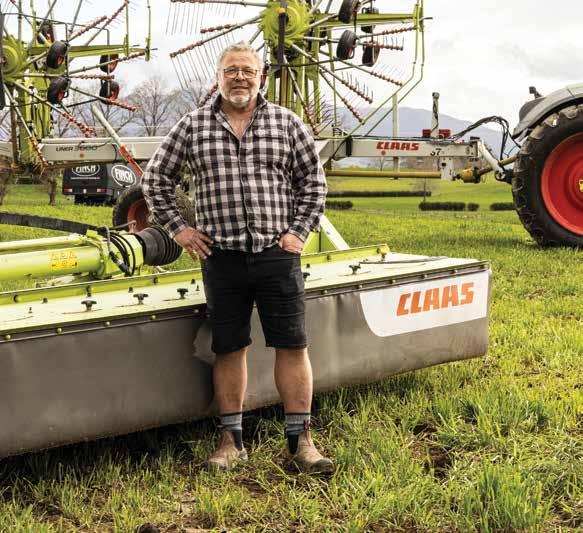
events, this will not cover all the urgent work that needs to be undertaken to restore farmers’ and growers’ operations.
“That legislation in the wake of the earthquakes was very helpful,” he says.
Hoggard notes that given the severity of the impact of the cyclones - with devastation to the land that appears to exceed that of the Christchurch earthquakes - the usual time-consuming RMA processes will impede progress.
ACT agriculture

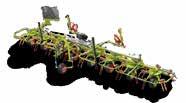
spokesperson Mark Cameron says there are so many issues that are front of mind for people affected in rural areas.
“I have heard from countless farmers who have told me they just want to get on with sorting their properties out but are held back by red tape,” he says.
He says they have enough on their plate and should be able to deal with cyclone impacts with as little red tape and bureaucratic interference as possible.
“The impact of sedimentation, slash and debris is a huge problem for farmers and growers to contend with. There needs to be flexibility for dealing with the mess,” he told Rural News
“Store lambs can’t get to slaughter because of damaged bridges and roads, people are cut off from getting feed for their animals and veterinarian supplies.”
Cameron says the Government should just step aside and let people get on with cleaning up.
“Having to apply for a resource consent to move tonnes of sediment that has washed up onto
your orchard or farm or dispose of tonnes of destroyed fruit or crops is unnecessary and the last
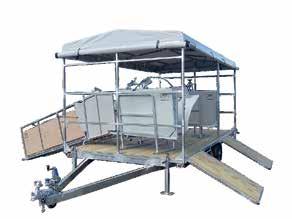
thing people should have to do.”

“After the Kaikōura earthquake, Parliament passed a temporary emergency relief Act. I am sure that if similar or other measures are necessary after Cyclone Gabrielle, we will make those changes.”Environment Minister David Parker isn’t ruling out amending the Resource Management Act for urgent repairs on flood-ravaged farms.
“ CLAAS gear is reliable and the service team is always there when we need them.”
“IT’S ALL about clawing our way back from a pretty ugly position of a week ago.”
That’s how Richard Burke, chief executive of Leaderbrand – one of the largest horticultural operations in the region – described to Rural News what happening a week after cyclone Gabrielle stuck the district.
The cyclone has badly damaged some horticultural businesses, but strangely, only relatively minor damage to others.
The word variable seems to sum up the situation.
However, the issues around infrastructure –in particular roading –seem destined to be a long term fix. The state highway from Gisborne to Napier is likely impassable for up to six months.

When we spoke to Burke, the biggest and most immediate problem for Gisborne was water. Water to wash newly harvested crops and for meat processing plants, not to mention cleaning up and its use in retail establish-
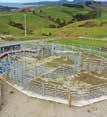
ments such as restaurants.
“We have got very limited water here at the moment and we are hoping this can be resolved soon, although we may have options on site that we can utilise,” he says.
What Burke is talking about is a huge dam Leaderbrand has built to supply water for a 10 hectare covered area designed to protect certain crops. He says their outdoor crops were largely saved by a new
stop bank that was built last year, which prevented them from being inundated by floodwaters.
“Where we have good protection we have had good crops, so we are harvesting lettuce, sweetcorn, some salad crops and grapes from our vineyard,” he told Rural News
“We have road access out via Opotiki and we are getting everything out that we can to markets.”
Burke can’t put a percentage on the amount of crops going out and
says now is not the time to start running numbers and doing calculations. He says the focus is just on doing what is possible and working as hard as possible to do this.
“We still have of stuff here and we have still got a lot of opportunity but it’s a battle and we are battling and we are not going to give up.”
Leaderbrand also has commercial growing operations in Pukekohe, Matamata and in Canterbury, which is part of the company’s risk and
resilience plan. Burke says the various operations support each other and that has helped keep the company in the game and keep the supply lines open.
He says the other sites have also had challenges, but overall, this plan has allowed Leaderbrand to maximise opportunities.
Another action the company has taken to manage risk is to build a huge 10.7 hectare canopy over some of its prime land. The $15 million dollar project includes a

WEEK TWO is reality week Richard Burke says.
He told Rural News that after the initial shock of the disaster, there is now time to breath and look at the losses and the challenges that lie ahead, which is hard.
He says Cyclone Gabrielle was tough on staff and they worked on adrenalin in the first week and are tired. But Burke says the focus, in the past week, has been to get some normality back into life, such as opening schools and people getting back to work.
He says the aim is getting people productive and doing things they usually do, not sitting around – that just makes things worse, he says.
“We are lucky in that we have dedicated teams of people who want to work so that is not something we have to worry about.”
Burke believes it is now time to stand up and think about how the region can get more resilience into its infrastructure.
“The time has come for the community to puts its foot down and say, ‘how do we spend our money on infrastructure to make our roading, power, water and communications networks better?’” he says. “Because they are the things that are going to support us in this region.”
40 million litre dam that takes water from the roof of the canopy and provides irrigation. Burke says some of the structure has been completed and is fully operational.

“The problem is getting it finished and this is the second cyclone to hit us, so we are well behind on the build. But we suf-
fered very little damage to it from Gabrielle, which was good.
“We had intended to put flood control in on that site but that hadn’t happened, so we did have bit of water get in there. It works very well but it is only another tool in the tool box and nothing is 100% safe,” he says.
RURAL SUPPLY and services company PGG Wrightson has announced reduced profits for the first half of the financial year, largely because of increased operating costs and a tough climate for rural real estate.




Highlights of the results for the six months to December 31 2022, include operating EBITDA (earnings before interest, taxes, depreciation and amortisation) of $47.8 million (up $0.4 million or 0.9%) and revenue of $585.8 million (up $33.4 million or 6.0%) – but net profit after tax of $21.2 million (down $1.3 million or 6.0%).
As a result, PGW has revised its operating EBITDA guidance for the full financial year to June 30, to $57 million, down from $62 million.

Nevertheless, the company has announced an interim dividend of 12 cents per share, to be paid on April 4.
In a statement releasing the figures on February 21, PGW Chair Joo Hai Lee said the result included new revenue and earnings highs for the Retail and Water Group, which generates the majority of its earnings in the first half of

the financial year.
“This was partially offset by challenges in our Agency business, in particular our Real Estate business. The overall trading performance reflects the healthy state of the Group and demonstrates the value that our customers see in the technical expertise of our people and PGW’s full service offering.
“It is pleasing to see
results that reinforce we are strategically on the right track as a business and are perceived as the ‘Leaders in the field’ in the sector,” Lee said.
Chief executive Stephen Guerin told Rural News the profit was affected by increased operating costs including wages and interest.
The regulatory regime facing the dairy industry in particular had
GUERIN SAYS the impact of Cyclone Gabrielle remains a developing situation. Speaking more than a week after the peak of the storm, Guerin said some Hawkes Bay horticulture crop losses seemed not as bad as first thought “but it is still early days.”
Some PGW customers were completely decimated, he told Rural News. “We’ve seen photos of some orchards where there’s not a tree standing, so it’s a case-by-case basis.”
There were also animal health issues
impacted rural real estate, he said.
“We sold several sheep and beef properties but there’s been a lack of interest in dairy properties, lifestyle and rural residential spaces,” Guerin told Rural News “They have fallen quite dramatically.”
Lee said New Zealand’s farmers and growers are facing a range of uncertainties and farmer
emerging, with reports coming out of MPI of footrot and lice because of the hot humid conditions. Getting the water and silt away was still a priority.
“Trees and vines don’t like standing water and they need oxygen so that’s a real focus.”
Guerin says PGW team members were in the field helping move silt and debris. The company had also made donations to the Rural Support Trust and volunteers were working with St Johns and Search and Rescue.
confidence is low.
“Our clients are experiencing an environment with rising interest rates, tightening credit, increased input costs, labour shortages, supply chain disruption, an uncertain geopolitical and domestic regulatory landscape, and adverse weather events including the extraordinary impacts of Cyclone Gabrielle.”





However, PGW still
saw positive fundamentals in the medium to longer-term.
“The primary sector has performed well and the PGW board is pleased with how PGW has traded. There is strength in the diversity of the PGW’s portfolio of businesses and the way the business is executing on its strategy.”
@rural_news facebook.com/ruralnews
upcoming director elections.
BEEF+LAMB NZ chair
Andrew Morrison knows he is in for a fight to hold onto to his seat in the
Morrison, who is up for re-election, faces a stiff challenge from former Southland
Federated Farmers president Geoff Young for the southern South Island seat.

“The fact the position is contested is a healthy
signal that B+LNZ is an organisation valued in representing the sector,” Morrison told Rural News
“The issue is not about personalities but
positions and what is important is that every farmer has their say in the process.”
ANDERSON he still has a lot of work to do.
Morrison says he is standing again because
“The job is not done, and I have something to offer. B+LNZ has always said government has tried to do too much too quickly and in doing this has ended up with poorly crafted and conflicting regs that disproportionately affect our sheep and beef farmers,” he explains.
“We have fought hard to get some concessions on the likes of winter grazing (pugging metrics/ sow-down dates) or recognition of sequestration in HWEN, but we need to keep pushing and the job is far from over.”
Morrison concedes that some farmers are disillusioned with both B+LNZ and DairyNZ leadership and want a change.
“I know farmers are overwhelmed and frustrated with the scale and pace of change – as am I. It’s been a relentless period with a tsunami of policy changes foisted on the sector,” he told Rural News

“Let’s be clear, it is the government with a 66-seat majority in a 120 seat parliament leading this, not us, and we have to work as hard as to try and get the best outcome for the sector.”
Despite the level of farmer criticism that B+LNZ has been too compliant, Morrison says the organisation is definitely not happy with where a lot of policy has landed.
“However, these are better than what government originally proposed. We have stayed out of the ETS, got a split gas target, avoided grandparenting rules in the Essential Freshwater process and I will keep fighting until we sort out the remaining issues like carbon farming.”
Morrison claims there have been times when B+LNZ has walked out on meetings or been told to leave because they have disagreed with government and/or officials.
“We have walked or been exited from several conversations, but we
don’t make a big scene. Our goal is to get the best result for farmers.”
Morrison concedes that it has been a battle for B+LNZ to walk the tightrope of fighting for farmers in the face of a Labour government with a strong majority.
“That means sometimes we have to sit at the table with Government and convince them to fix their proposed policy,” he explains. “Examples of this are the winter grazing changes and the split gas model.”
He says farmers do not see the work that goes on behind the scenes to lobby government and officials.
“I know that lack of transparency can be frustrating. But we are always standing up for farmers. For example, B+LNZ and DINZ were the only two groups to oppose mandatory farm plans.”
Morrison cites as examples of where B+LNZ achieved wins for farmers included the avoidance of grandparenting in the original Essential Freshwater Rules, split gas model and staying out of the ETS. Changes made to winter grazing and the continued pause on Indigenous Biodiversity rules.
“It is working collaboratively with other sector groups, as our levy payers clearly asked us to do, that has collectively delivered this.” he adds.
“This is quite interesting as often it is pitched that there are significant differences in policy positions taken by various organisations, I would strongly contest you have never seen a stronger united view on HWEN –EFW and NPS on IB and would challenge Geoff to
highlight the alleged differences.”
Morrison says on the criticism of HWEN, that B+LNZ has always been clear that it would prefer that farmers didn’t face a price on their emissions.
“However, the government has clearly stated it will price emissions and originally intended to bring us into the ETS,
which would have been financially devastating to farmers as the price of methane would have been linked to the carbon price,” he explains.

“B+LNZ and others convinced them not to do this, which was a significant outcome, but the condition was on the premise that we had to come up with an alterna-
tive pricing framework.”
Morrison stresses that B+LNZ has always stated it will not accept a pricing system that will have a disproportionate impact on sheep and beef farmers. “And we will walk away if necessary.”


If re-elected, Morrison says he will continually press government on a range of issues.

THE 2023 kiwifruit harvest season has kicked off with growers bracing for lower yield and poor quality fruit.
New Zealand Kiwifruit Growers Incorporated (NZKGI) says adverse weather over recent months has meant that the 2023 season is forecast to be a lower volume year than last year’s 160 million trays exported to overseas markets.
NZKGI chief executive Colin Bond says this season looks to be an “extraordinarily challenging one” for growers.

He says NZKGI is focused on alleviating a range of pressures on many growers at this time.
“There is also a wider concern with the recent climatic conditions,
including lack of sunlight hours, which may impact on fruit growth as harvest
approaches,” Bond told Rural News
“There is also a wider concern with the recent climatic conditions, including lack of sunlight hours, which may impact on fruit growth as harvest approaches.”
Bond says the industry has been working hard to lessen ongoing quality issues that hampered last years’ harvest.
“Growers have also faced adverse weather effects such as hail,

2023
Rarotonga Relaxer - 17 May*
8 days tropical Cook Islands, beachfront
Vivid Sydney - 25 May
5 days Vivid Festival ,Tina The Musical
Sunshine Coast - 13 Jun*
8 day Winter Sun, Coast & Mountains
Cairns & Port Douglas - 6 Aug
12 days Barrier Reef, Fitzroy Island
Canada & Alaska - 13 Sep

21 days Rocky Mountaineer & Cruise
Southern Africa - 17 Sep
20 days Wildlife, Victoria Falls, Botswana

Perth Wildflowers - 12 Oct
11 days Spectacular Wildflower Festival
Tasmania Spring - 2 Nov
11 days Wild Beauty of Tasmania
* $250 per person off Rarotonga & Sunshine Coast until sold out. (Offer is not combinable).
ONE OF the country’s largest kiwifruit traders, Seeka, says the full extent of the impact on the 2023 crops will likely remain unknown until the fruit is harvested.
The listed company says its core Bay of Plenty kiwifruit growing region was spared the worst by Cyclone Gabrielle.
However, the Hawke’s Bay, Gisborne, Coromandel and Kerikeri regions had varying degrees of impact, with Hawke’s Bay being worst hit. Approximately 5% of Seeka’s kiwifruit supply is grown in the Hawke’s Bay region.
frosts, cyclones and associated flooding in the lead up to harvest that have impacted on kiwifruit volumes. Combined with a year of poor opening of flower buds which form kiwifruit, this season looks to be an extraordinarily challenging one for growers.”
The lower forecast volume for 2023 means the sector will need less labour than 2022, which required 24,000 people to pick and pack the fruit.
The reopening of New Zealand’s borders, lack of Covid-19 and downward economy also indicates a temporary respite from the severe labour shortages of previous years.
However, Bond points out that the drop in volume of kiwifruit produced in 2023 only provides the industry with temporary relief. The pressure to source sufficient labour in 2024 is forecast to return when volumes significantly
increase.
New Zealand has approximately 2,800 kiwifruit growers located from Kerikeri to Motueka.
“The industry must work together to ensure the 2023 season runs as smoothly as possible despite the curveballs being thrown,” Bond told Rural News. “I encourage kiwis to get involved in the industry, whether it be picking, pruning, packhouse work or otherwise.”
UltraGlide mastshift
• Leg Roller
• Sidemount 900 Unit
Retail Price: $31,750 + GST
Special Price: $28,500 + GST
Available Nationwide and throughout March 2023
Northland Field days: Site E11

Central Districts Field days: Site C17/C18
Southland Field days: Site 738
Beat the field days rush, order yours today!
Seeka chief executive Michael Franks told Rural News the 2023 kiwifruit volumes are expected to be lower than the 2022 harvest year due to an early season frost, variable bud break and Cyclone Gabrielle. “Our response to this circumstance includes a reduction to the 2023 capital expenditure programme and a focus on reducing costs in line with the lower crop expectation.”






BRITAIN’S HIGH Commissioner to NZ Iona Thomas says there’s a heightened awareness by UK consumers about the food they buy.
Her comments come as the UK moves towards ratifying the FTA reached last year. NZ has already ratified the deal.
Thomas says with the tight global economic situation, consumers are becoming more conscious about the choices they make and are looking for value for money among other things.
“Increasingly we see people wanting to identify with brand value and understand the story behind different brands,” she told Rural News
“So, food provenance is a big issue and I think that producers need to be able to tell the whole story about what underpins their products.”
Thomas says the UK is a very large market for NZ and one with very engaged consumers who are really interested in buying food products.
“We know that NZ farmers produce very high value products and this resonates quite well with consumers,” she explains. “The UK will provide great opportunities for a range of primary industry and horticulture products.”
Thomas took up the role of UK High Commissioner to NZ towards the end of last year, after the FTA was already completed. She says the
arrangement is a great opportunity for farmers and businesses both in the UK and NZ to do business more easily and more cheaply.
She believes there is broad support for the FTA in the UK, although it’s understood that the UK farmers’ lobby is still unhappy, as they have always been when a deal with NZ has been struck.
Thomas says while the FTA opens up opportunities for NZ primary producers, the UK is looking to increase its exports of cars, machinery and consumer goods. A key point of the FTA, from a UK perspective, is the right for that country to expand in the services area such as legal and financial.

One particular aspect of the FTA was the inclusion of a ‘Māori chapter’.


“This is ground-breaking and there is real opportunity to use that to talk about Māori business opportunities in the UK,” Iona claims. “This is an area we are really excited about.”
As well as the signing of the FTA, Thomas points to another signing that took place earlier last year – a memorandum of understanding on research, science and innovations.
She hopes this will lead to greater collaboration between the two nations in this space. She notes that at last year’s Fieldays, there was group from the UK who were looking to explore opportunities in the agritech area.


THE A2 Milk Company (a2MC) says returning its Southland-based Mataura Valley Milk (MVM) plant to profitability remains a key strategic focus.
For six months ending December 31, 2022, MVM reported a loss of $13.4 million on revenues of $45.7m.
MVM has been insourcing additional a2 Milk whole milk powder volumes from Synlait Milk, while continuing to produce products for third parties.
Releasing a2MC’s halfyear results last week, chief executive David Bortolussi, who also chairs the MVM board, says the loss reflected the current production mix with the plant primarily selling lower value milk powders on the commodity market.

“MVM is prioritising in-sourcing a2 Milk skim milk powder and certain other nutritional prod-

ucts from Synlait, developing future product innovation at the facility and exploring additional third-party customer opportunities,” says Bortolussi.

“To complement this and facilitate future China label GB registration applications, MVM is planning for the installation of a laboratory and blending and canning capability at the site
and continues to review options to accelerate this strategy.”
The MVM plant, which started processing milk in August 2018, was built by the China Animal Husbandry Group: a2MC bought a 75% stake in the company in July 2021. a2MC also owns a 19.8% stake in Synlait and has a manufacturing and supply agreement for infant formula with the
listed milk processor.
Bortolussi says a2MC’s half-year results are in line with the company’s expectations with double digit revenue and earnings growth.
Infant milk formula (IMF) sales grew 18% in a challenging market with China’s IMF market down 12.5%. Growth was driven by China label IMF sales with record market shares.
Revenue grew 18.6% to $783.3 million. China & ‘Other Asia’ sales were up 54%, ANZ sales down 24.6%, US sales up 61.8% and MVM sales up 18.4%. Within IMF sales, China label sales were up 43.5% and English label sales up 1%. Liquid milk sales in ANZ and US were up 5.6% and 62% respectively.
“We are pleased with progress in implement-
ing our refreshed growth strategy focused on the China market and improving our execution in the face of significant market headwinds and Covid related challenges,” says Bortolussi.
Despite challenges, he says a2MC is continuing to deliver against its refreshed growth strategy.
The company is expecting “low double digit” revenue growth

this financial year supported by growth in China label IMF, Australia and New Zealand (ANZ) liquid milk and US liquid milk sales.
Bortolussi says MVM sales are expected to be down on last year’s reported sales due mainly to higher internal sales to a2MC from in-sourcing, and lower global dairy trade (GDT) commodity pricing.

He listed some key challenges as Covid-19’s impacts on supply and demand, achieving regulatory approvals in China, volume impact of price increases, cross border trade, foreign exchange movements, changes in interest rates and commodity prices, and changes in the regulatory environment.
“These challenges and risks could materially impact expected revenue and earnings outcomes,” Bortolussi says.
@rural_news

Salmonellosis is over 2.5 times more prevalent than in 20131
Salmonella is widespread on New Zealand farms and cases have increased nationwide1. Striking without warning and spreading quickly, Salmonella can pass from your stock to the ones you care about most.

Vaccinate today to reduce the destructive impact of an outbreak*.
SALVEXIN®+B NEW ZEALAND’S ONLY SALMONELLA VACCINE FOR SHEEP AND CATTLE

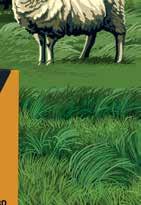
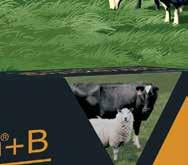






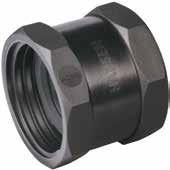





A NEW report by Rabobank suggests that 2023 will prove to be an uphill climb for New Zealand agriculture, with the difficulty of the climb hinging on four main ‘wildcard’ factors.

In the bank’s February New Zealand Agribusiness Outlook flagship report, it says the industry traversed a mountain of challenges in 2022 and a testing climate confronts the sector as it begins its 2023 journey.

It cites these contributing factors: continuing Covid aftershocks hampering exports to China, the war in Ukraine disrupting market access and creating a surge in farm input costs, and La Nina weather patterns returning for the third year in a row bringing floods across the country.
Report co-author and senior agricultural analyst Emma Higgins says government policy impacting the sector continues to be a major source of concern, with weakening market prices across multiple sectors further contributing to already low confidence levels.
“All of this exists amidst a potent background of climate change urgency, a cost-of-living crisis, geopolitical fragmentation and extremely tight labour markets,” Higgins explains.
“The first quarter in particular looks tough, and we antici-
pate low profitability will push some businesses to assess income diversification streams and explore complementary revenue options over the course of the year ahead.”
With the report saying many of these challenges look likely to linger, it says 2023 runs the risk of being characterised by margin pressure for many operators.
Within this challenging outlook for the sector, Higgins says several divergent paths are possible, largely shaped by four ‘wild cards’.
The first of these is the re-opening of China after the country’s Covid U-turn.
“With the Covid-19 wave now spreading rapidly in China, adverse short-term impacts will likely be felt on supply chains via temporary labour shortages along with a light recession.
“We think the journey might still be a bit bumpy, but there remains a chance that demand could improve earlier than forecast, with food services picking up after long lockdowns providing a boost for commodity prices and New Zealand farmer bank accounts.”
Global and domestic inflation shows up as the next wildcard, with policy makers across the globe trying to keep inflation under control, but with interest rates still having a ways to go.
The third wildcard indicated in the report is
• Dairy - Commodity prices near-term headwinds likely to continue before returning to more promising levels in the second half of 2023.
• Beef - RaboResearch anticipates that the North Island bull price will track above the five-year average price range in 2023, supported by tight global beef supplies.
• Sheepmeat - Lamb and mutton schedules face headwinds in all key markets. Import demand from China likely to improve from mid-2023.
• Venison - Despite challenging economic conditions in all key markets, venison schedule is expected to continue to recover.
• Farm Inputs - Overall supply and demand is adjusting itself to the new normal and the price soars are dissipating.
• FX - The Reserve Bank shows no sign of backing off with inflation still high. Higher interest rates and inflation are driving down consumer confidence.
• Regulation - More regulation milestones loom ahead for farmers, from freshwater environment plans to the fate of the Three Waters reform programme.
market push for low or zero emissions products.
“New Zealand has an early-mover advantage to supply low-emissions produce into these supply chains and countries with opportunities to leverage our emissions pricing framework to unlock further value.
“The direction of
travel for change in New Zealand agriculture is largely set – so we must act quickly to leverage the opportunities presented locally and globally,” Higgins says.
Finally, the report highlights the 2023 election as another variable to influence the year ahead for agriculture.
While 2023 is expected to test the industry’s resolve, Higgins says New Zealand’s farmers and growers have shown the drive to successfully tackle the challenges that come their way.
“This isn’t the first time commodity cycles or regulation have changed,” she adds.
Dairy COMMODITY
MARKETS start the new year on softer ground and with a weaker tone to linger into New Zealand’s new season. Commodity prices have been losing momentum since the midpoint of 2022.
Underlying
fundamentals have soured as milk supply recovers across much of the export engine and at a time when Chinese importers are more cautious with purchases.

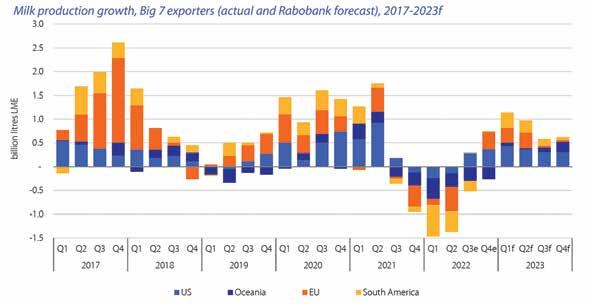
Rabobank anticipates the start of the new season will likely see some improved pricing
however, farmgate milk price opening forecasts are likely to be less optimistic than last season. term.
Any potential upside rally hinges on a supply shock out of the Northern Hemisphere or a meaningful recovery in Chinese demand.
Beef GLOBAL BEEF pricing will be shaped by converging pressures in 2023; tightening global beef supplies and weakening consumer demand.
It is not clear whether supply or demand side pressures will be the
Demand from China is likely to show recovery from Q2, as it emerges from the economic effects of widespread lockdowns in 2022.
In the US, a recessionary environment is expected to drive up the consumption of lower value cuts such as mince, supporting demand for New Zealand lean trimmings. RaboResearch anticipates that the North Island bull price
will remain above the five year average price of NZ$5.50/kg cwt in 2023, but is not likely to return to the highs seen in 2022.
The tidal wave of demand for sheepmeat, and the subsequent surge in pricing seen in 2022, is now being sucked away by weaker economic conditions in New Zealand’s key markets and by increased
Australian lamb supplies.
The widespread lockdowns in China which reduced sheepmeat demand in 2022 and negatively impacted NZ export values, are over.
Modest economic recovery is forecast in China in 2023 RaboResearch forecasts GDP to increase 4.2% however, a far cry from the 8.1% growth achieved in 2021.
Demand for mutton and lamb is expected to remain weaker in the first half of 2023. In New Zealand’s other key sheepmeat markets the UK, Europe and the US recessionary conditions will continue to impact both foodservice and retail channels.

THE WORST is now behind the deer industry, with the venison schedule showing steady recovery through 2022, from the Covid induced lows of 2020.
Increased demand
from the US and China were the key drivers behind the lift in farmgate returns.
In the US, the reopening of the foodservice sector drove a lift in import demand, but a surge in home cooking and general demand for animal proteins also helped to lift venison sales via retail. In China, ongoing efforts to develop a premium
consumer market are paying dividends, with the average export value lifting 10% YOY to NZD 16.75/kg.
A favourable exchange rate also helped to buoy returns. RaboResearch expects that the farmgate venison price will remain resilient through 2023, but further growth in the short term could be hampered by tough economic conditions

in the US, China and Europe.
WITH INFLATION
still scorching hot, the Reserve Bank shows no sign of backing off, adding that the cash rate “needs to reach a higher level, and sooner” to return inflation back within its 1% to 3% target range.
Another hike is
EDGETM granular technology provides unmatched stability with 3 mechanisms of action:

• LACTIC ACID PRODUCING BACTERIA (Competitive inoculants are typically either bacteria or preservatives, EDGETM puts both in the bag.)
• A PROVEN MOULD INHIBITOR
• OXYGEN SCAVENGING TECHNOLOGY
EDGE TM is proudly made in New Zealand. This means that EDGE TM supports the Kiwi economy rather than padding pockets of offshore multinationals.

expected in late February. Wage inflation is likely to remain buoyant and that the RBNZ has more work to do to stem inflationary pressures.
We see the potential for NZD/USD to dip back to its January low in the 0.62 area on a three to six month view.
However, we expect NZD/USD to end the year on a stronger note.

@rural_news
facebook.com/ruralnews
AS THE initial shock of the devastation to large parts of the rural landscape in the North Island by Cyclone Gabrielle eases, attention now turns to the recovery and rebuild.
As the head of Gisborne-based horticulture company Leaderbrand, Richard Burke, explains in this issue, following the initial shock of the disaster, now is the time to look at the losses and the challenges that lie ahead.
There is no doubt that those challenges are going to be great and many. As communications are gradually restored, a more accurate picture of the scale of devastation can be drawn. It will then be up to affected communities, as well as government and officials, to set priorities and fix the damage.
Reports from the affected areas describe the impact of the cyclone as ‘variable’. Some places have suffered little damage, while others have been hit terribly.
Early estimates suggest that up to 35% of the apple crop in Hawkes Bay could be lost. At this stage there is little knowledge or understanding of the impact on other primary sectors. However, it can be assumed that this will be major.
One of the first issues that needs to be addressed is access: bridges and roads were washed away and will take time to repair. Ironically, water is another big issue. As Gisbornebased farm consultant Peter Andrew points out, “There is barely enough for domestic use, but insufficient for industry, such as the meat processing plant and horticulture operations, which need water to wash produce”.
A key priority in any rebuild must be a serious look at the infrastructure around communications in rural and regional NZ.
In the aftermath of the cyclone, many impacted areas had no phone or internet coverage for days and even weeks. That is third world stuff and unacceptable – not to mention dangerous – in a country like NZ.
While there will be a time to debate the causes and mitigations that we must take to prevent similar events happening, that time is not now.
For the likes of Greenpeace to point the finger of blame at farmers – many of whom have lost lives and livelihoods – for Cyclone Gabrielle is low rent, cheap and downright inappropriate.
It is time for us all to rally behind those affected and do what we can to help.
We have already seen fellow New Zealanders pitch in with goods, money and diggers to help out those in affected areas. That is NZ at its best.
TO ALL FARMERS, FOR ALL FARMERS
HEAD OFFICE POSTAL ADDRESS: PO Box 331100, Takapuna, Auckland 0740 Phone 09-307 0399

PUBLISHER: Brian Hight Ph 09 307 0399
GENERAL MANAGER:
Adam Fricker Ph 021-842 226
CONSULTING EDITOR: David Anderson Ph 09 307 0399 davida@ruralnews.co.nz

Your old mate understands the battle for the southern South Island seat on the Beef+Lamb NZ board could well be skewered by the weighted voting method used in director elections. Current BLNZ chair Andrew Morrison is under pressure to hold on to his seat from former Southland Feds head Geoff Young. The challenger already has the backing of rural lobby group Groundswell and other farm leaders in the region. However, Morrison may well be saved by the weighted voting system, which is based on livestock numbers for each farm, and not one farm, one vote. BLNZ claims this system does not give big livestock owners the chance to ‘influence decision making’. However, with livestock numbers that Landcorp farms in the southern region and its support for BLNZ’s unpopular stance on HWEN, the Government’s farmer is highly likely to put its huge number of votes in favour of Morrison.
The Hound suggests if anything good can come out of the utter devastation that hit many parts of the rural community in the North Island in the wake of Cyclone Gabrielle, it would be a serious re-look at the vulnerability of communications and connectivity in rural NZ. This has been a major problem for years, with patchy internet coverage and loss of mobile phone coverage in many parts of the country’s rural hinterland during normal times. It is clear that much of the internet and mobile phone infrastructure in regional and rural NZ is not up to scratch, with regions like Wairoa and parts of the Hawkes Bay completely uncontactable during Cyclone Gabrielle. This is unacceptable, dangerous and abrogation of duty by those in charge of this infrastructure and needs to be one of the first issues looked at and addressed in any subsequent review of this disaster.
PRODUCTION: Dave Ferguson Ph 027 272 5372 davef@ruralnews.co.nz
Becky Williams Ph 021 100 4381 beckyw@ruralnews.co.nz
REPORTERS: Sudesh Kissun Ph 021 963 177 sudeshk@ruralnews.co.nz


Peter Burke Ph 021 224 2184 peterb@ruralnews.co.nz
MACHINERY EDITOR: Mark Daniel Ph 021 906 723 markd@ruralnews.co.nz
A UK ugly dog competition has found a canine that they believe is the worst looking in the entire world. However, the organisers are now considering launching a world-wide ugly dog competition to see if any canine can be as bad looking as their UK winner. Apparently, they are launching a new contest to find the world’s ugliest dog and are inviting entries from dogs from all four corners of the earth. A spokesman for the company said they were only interested in receiving photos of ‘downright ugly dogs’ and warned that pretty pets need not apply. Your canine crusader was somewhat taken aback when this piece of news was slipped through the door of his dog kennel – along with a mug shot and entry form. To be fair, yours truly has a face only his mother could love and may well be a strong contender for this international title!
AUCKLAND SALES REPRESENTATIVE: Stephen Pollard Ph 021 963 166 stephenp@ruralnews.co.nz
WAIKATO SALES REPRESENTATIVE: Lisa Wise Ph 027 369 9218 lisaw@ruralnews.co.nz
PRINTED BY INKWISE DISTRIBUTED BY REACHMEDIA
Slash and burn?
This old mutt reckons a proposal by ACT to change resource management legislation to ensure accountability in the aftermath of Cyclone Gabrielle, which brought rivers of slash down through the East Coast is worth looking at. Spokesman Simon Court suggests such a change would mean people and property impacted by forestry slash are properly compensated for any loss. “The responsibility for the damage incurred by slash would lie with forestry companies,” Court explains. “Meaning it is their responsibility to find a solution and dispose of the debris before situations like this occur.” As he points out, on a property rights basis, people can do anything that does not harm others’ enjoyment of property. Maybe it is time to start a ‘filthy forestry’ campaign to put pressure on the forestry sector to clean up its act!
WELLINGTON SALES REPRESENTATIVE: Ron Mackay Ph 021 453 914 ronm@ruralnews.co.nz
SOUTH ISLAND SALES REPRESENTATIVE: Kaye Sutherland Ph 021 221 1994 kayes@ruralnews.co.nz
DIGITAL STRATEGIST: Jessica Marshall Ph 021 0232 6446
This fact sheet provides information for farmers, growers, rural businesses, and Māori landowners to help you deal with the impact of Cyclone Gabrielle. The Ministry for Primary Industries (MPI) is meeting regularly with the sector to focus on the support required for farmers and growers.
Help is available from many sources. MPI, sector groups, Rural Support Trusts, Civil Defence, other agencies, local councils, and community groups are there to support you.
Farmers, growers, and whenua Māori owners significantly affected by Cyclone Gabrielle can get grants to kick start recovery efforts.
The Government has allocated an initial $25 million to help farmers and growers pay for work, including fencing, and clearing silt to save trees and vines.
The funding includes:
• Grants for pastoral and arable farmers of up to $10,000 to help initial recovery on-farm, such as repairs to water infrastructure for stock and fencing to contain stock.
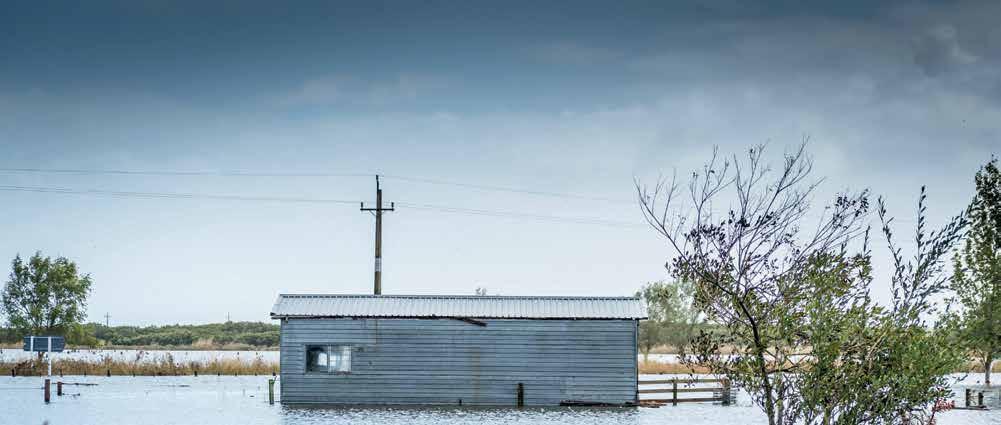
Civil Defence payments are available if you have been affected by the cyclone.
You can visit the Work and Income website or call 0800 400 100 or for more information.
The Ministry for Primary Industries (MPI) and Federated Farmers have restarted the national Feed Coordination Service. The service helps match people with grazing or supplementary feed for sale to those who need it.
Phone: 0800 FARMING (0800 327 646)
Or register online:
Grazing needed https://arcg.is/0eTPSK0
Grazing available https://arcg.is/OWneD
Feed needed https://arcg.is/11z9mz0
Feed available https://arcg.is/1azj0n
Each of the country’s 14 Rural Support Trusts have local, rural people who know from experience that pressures can mount up. Your local trust can provide support and advice. Talking to them is confidential, and free of charge. They can connect you with the services you need, whether it’s financial and business advice or health services.
Farmers can contact the Rural Support Trust on 0800 RURAL HELP or 0800 787 254. Please see the Rural Support Trust website for more information.
• Grants for growers of $2,000 per hectare up to a maximum of $40,000 to remove silt from trees and vines, support clean-up, and minimise future losses.
Grant applications are open. You will find more information at: www.mpi.govt.nz/cyclonerecovery or phone 0800 00 83 33
This $4 million targeted funding is to help with urgent primary sector needs that are not being met by other organisations.
The Ministry for Primary Industries (MPI) is working with national and regional response teams, sector groups, whenua Māori entities and Rural Support Trusts, to identify areas of greatest need.
We will consider ideas for works, services and initiatives that meet the immediate needs of rural communities.
If you are a sector or regional group with an urgent need related to rural communities significantly affected by Cyclone Gabrielle please email funding@mpi.govt.nz
Contact your local veterinary practice for support for any injured or sick animals.
The New Zealand Veterinary Association has information and guidance if your animals have been exposed to flood water, including signs to look out for: https://nzva.org.nz/public/ flood-resources-public
National Emergency Management Agency (NEMA)
NEMA has a helpful factsheet on the support available following Cyclone Gabrielle.
Please visit the NEMA website for more information, including who to contact.
Ministry for Business, Innovation and Employment (MBIE)
MBIE has information and advice for businesses affected by Cyclone Gabrielle, such as:
• looking after your employees
• operating safely
• insurance claims
• finance and banking
• buildings and landlord responsibilities.
You can find more information on the MBIE website
Below is guidance growers and farmers may find helpful.
Guidance for harvesting produce affected by flood waters

New Zealand Food Safety has released guidance for growers who are harvesting produce affected by flood waters.

The guidance is available on the New Zealand Food Safety website
Sector groups are a key source of help, support and information, and are in touch with their members directly.
DairyNZ www.dairynz.co.nz
Phone: 0800 4 DairyNZ (0800 4 324 7969)
Email: info@dairynz.co.nz
Beef and Lamb New Zealand https://beeflambnz.com
Phone: 0800 BEEFLAMB (0800 233 352)
Email: enquiries@beeflambnz.com
Federated Farmers of New Zealand www.fedfarm.org.nz
Phone: 0800 327 646
Horticulture New Zealand – Ahumāra Kai Aotearoa www.hortnz.co.nz
Phone: +64 4 472 3795
Email: info@hortnz.co.nz
Ministry for Primary Industries

www.mpi.govt.nz
Phone: 0800 00 83 33
Email: info@mpi.govt.nz
In the Hawke’s Bay, the regional council is leading the disposal of dead livestock and is receiving and coordinating calls for collection and disposal.
If already on farm, farmers may be able to bury their own dead livestock as per normal conditions:
• Consider proximity to waterways – should be >50 m from a waterway
• Consider usual pest vermin control.
If not on farm, or there are too many on the property for the landowner to deal with, please phone HBRC on 06 835 9200 or 0800 108 838. The council will coordinate collection and appropriate disposal.
Farmers elsewhere should seek advice from their local council and sector groups about the disposal of dead stock. Federated Farmers has developed regional guide on stock burial and offal pits, which can be found on the Federated Farmers website
DairyNZ also has a Dead Stock Disposal Best Practice
Guideline
These organisations can also provide help and support:
Mental Health Foundation https://mentalhealth.org.nz/ helplines
Depression.org.nz www.depression.org.nz
Phone: 0800 111 757
Text: 4202
Farmstrong https://farmstrong.co.nz
Email: info@farmstrong.co.nz
New Zealand Wine www.nzwine.com/members
Phone: 021 192 4924
FOR MY column this time, I planned to write about the weather event that hit us the night of February 1.
No weather warning had been issued for our area. Even with the rain
pelting down on our roof, nothing changed with the forecast. Daylight finally broke to reveal extensive damage to fences, culverts, and access tracks.
Close to 100mm had dropped on us in some-

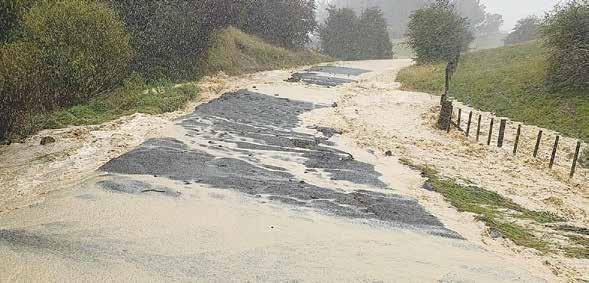
thing like 4 hours. That was a followup to more than 100mm over the weekend just before. It reminded me of getting caught in what we used to call “cloudbursts” many years ago.
I had to swim my horse through one of those to get myself home!
But then news from the devastating earthquakes in Turkey and Northern Syria came to our screens. Reading some of the reports and seeing some of the news coverage made our situation fade into utter insignificance.
The miracle of the little baby girl rescued with her umbilical cord still attached to her deceased mother. I subsequently read they have named her MIRACLE! Other rescue miracles, plus the 24/7 tireless work of the rescuers … heroes and heroines to be sure!
Now if that’s not enough, NZ has just been hammered by Cyclone Gabrielle. More stories are coming to light every day.
Again, reading some of the reports and seeing some of the pictures gives a whole different perspective to our own personal dramas here on the farm.
Yes, times like these give you the opportunity to think and reflect, probably a little deeper than we usually have time for. I offer some unhurried life lessons today that have helped me in my journey here on this tiny marble we call planet earth.
1. There are others worse off than you. I’ve never experienced being buried alive under earthquake rubble for days, not knowing if I will ever be found. I know nothing of famine; of holding my

starving little one in my arms as they leave this world.
2. The devastating event may have happened; you cannot change that. But you can choose how you react. You can choose your attitude; your response is up to you. I can now choose to give aid and assistance to those from the above, which will be great ‘therapy’ for me.
WWII Nazi concentration camp survivor Viktor Frankl saw them take his wife, his family, his possessions, and even his wedding ring. He said: “Everything can be taken from a man but one thing, the last of the human freedoms, to choose one’s attitude in any given set of circumstances, to choose one’s own way.”

3. Times like any of the above and more, are when true friends stand with you shoulder to shoulder in the midst of your storm. What a blessing to find you are not alone! You just can’t put a price on that.
For many years I had a quote pinned up on the wall of my office where I could see it every time I was there. To the best of my knowledge, it came from an American Indian elder.
Here it is: “It doesn’t matter who you are, or how you came to be here. I want to know if you will stand in the centre of the fire with me and not shrink back.”
I trust you have true friends like that. If you find yourself alone, you are most welcome to email me at the address below. And finally, I have seen, and experienced, that a real and active faith makes ‘all the difference in the world’ in the darkest of times.
Take care and God bless.







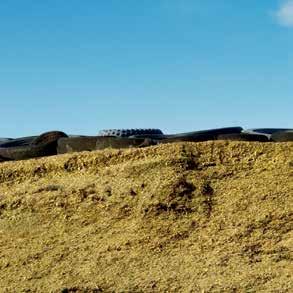











A question many strong wool growers have heard is why, for all its strengths and the push for wool products, is wool considered almost worthless? There is one big flaw in that question: wool isn’t almost worthless, it is an active drain on farmers’ businesses. Leo Argent looks at how the strong wool industry came to be where it is today and whether it can make a comeback.
IN 1951 the US was purchasing large amounts of wool to shore up its strategic stockpiles during the Korean War.
New Zealand wool tripled in value overnight, and even by 1966 when prices had dropped 40% there was still lots
of money to be found in wool. A heavily statemanaged economy and minimum price controls managed by the Wool Board meant there was little incentive to diversify.
But in 1973, Britain –our dominant trading
partner – joined the EEC (now EU) and reduced economic ties with New Zealand. Our predominantly sheep and beef based economy took a serious hit. Economic growth was slow, inflation and unemployment soared. Synthetic fibres for clothing and carpeting were becoming cheaper and more popular internationally, reducing demand for wool.
In 1984 a Labour government was elected and over the next six years enacted a series of economic liberalisations, reducing state control of the economy, dropping many agricultural subsidies and reducing import tariffs. Previously insulated from declining prices, wool farmers were suddenly confronted with a market in which their product was not valued or wanted.
From 34.8 million sheep in 1951, the industry continued to grow, reaching a peak of 70.3 million in 1982. Ever since the numbers have


continued to fall; latest Statista information lists New Zealand’s sheep population at 25.1m in 2022.
Auction prices for wool have kept falling in raw dollar value since the 1960s, a poor omen even before factoring in inflation. Dealers took to blending different grades of wool together to make a profit. However, the resulting poor-quality yarns drove many suppliers away from using wool, seeing it as unreliable, further hurting wools’ value compared to the lab-grown precision micron count that synthetics offered.
Without government support, wool growers established their own industry bodies such as
Wools NZ with the aim to provide independence and support for wool growers, establish links to suppliers and drive innovations in the industry.
Although these bodies do much to ensure wool isn’t adulterated in New Zealand, they cannot ensure that wool isn’t adulterated overseas –a problem Ken Alge of AgWool NZ calls “obscene”.

“Our wools got lost. Suddenly we don’t have control over the market anymore, the international people do. That’s a major problem,” he told Rural News
In the last decade there have been many solutions proposed to bring wool out of its economic slump, with traditional products like

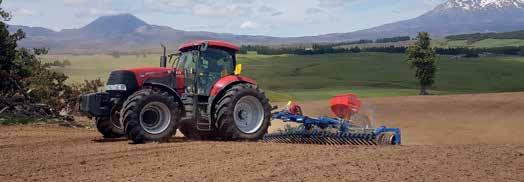

clothing and carpets contrasted with more experimental options like surfboard material and even filters for NASA life support systems.
With environmental awareness becoming a bigger issue as climate change effects become more pressing, wool’s eco-friendly credentials should give it a distinct advantage over synthetics. Many polls show people are willing to pay more for an environmentally friendly product.
However, as Wools NZ chief executive John McWhirter points out: what people say and do can be very different.
“What market research tells you can only be a guide. People might tell you they want
looked at the Hellers bacon which was about $5. She took the Hellers bacon. People’s disposable income will dictate their final decision, which is why we have to make wool [products] affordable.”
Another consistently reported problem was New Zealand’s lack of manufacturing base. Most products using NZ wool have to be manufactured overseas. While AgWool NZ scours and spins its wool into yarn in NZ, its carpets and underlay are manufactured in Australia.
McWhirter estimates domestic manufacturing capacity of about 5%.
farmers,” he told Rural News
Volume is a key factor here. McWhirter estimates that each year there is an oversupply of 45-50,000 bales of strong wool above market demand, pushing prices down. He believes creat-ing new and old products to soak up the excess wool will help bring prices back up.
“If you think about your car market, how many Audis would be sold in New Zealand versus Corollas? For the wool carpet market, we need to be Corollas, where the volume is.”
to do the right thing, but they won’t necessarily do that,” he says.
“When I was CEO for Hellers, I was in an Auckland Pak N Save and a lady came up and asked to buy free range bacon, explaining how important it was to her. I showed her some imported Hellers bacon and some bacon from North Canterbury with the pigs roaming around,” McWhirter told Rural News
“She said, ‘that’s the bacon I want’, looked at the price, which was about $8, and she
“There’s no indus-try or expertise here anymore,” Alge admits. “When you talk to people about what you can make, there’s not much understanding of that.”

Former Federated Farmers wool chair Miles Anderson says that for all the possibilities for strong wool, unless huge volumes are used, it won’t have any impact on the price farmers get or put pressure on other buyers to put their prices up

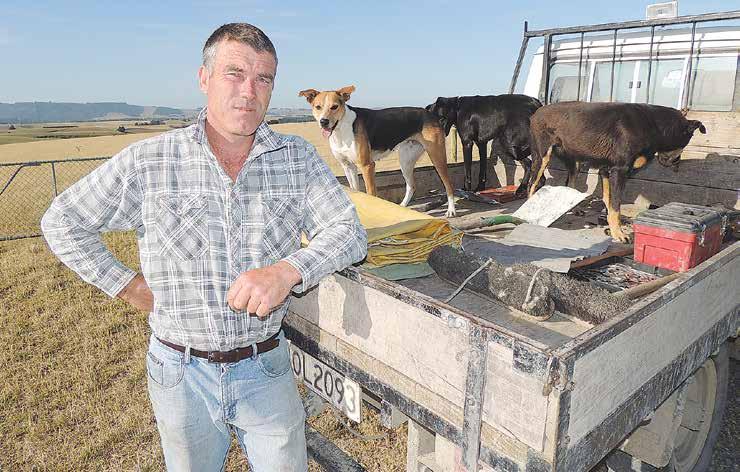
“In general, with niche products utilising or going into new technologies, that products, buyers are getting it directly from the suppliers and the price is not being reflected for the
All admirable goals, but the strain on farmers is a challenge to hold out.
“We were saying to a farmer: ‘you’ve got to class your wool’ but you’re paying half its value, so why would he do that?” asks Alge.
“The answer is, if he doesn’t, it just drops further down the hole, but he’s losing money every time he does. Some of these guys have been doing this for years. One guy got $8,000 for his wool, which cost $17,000 to shear. They’re losing faith.”
On the projected future for strong wool, Anderson believes that there are lights on the horizon. “I’m just worried it may not come quick enough for the industry as a whole.”
TO ENSURE farmers have easy access to the information around informed plant genetics selections, the New Zealand Plant Breeders Research Association (PBRA) has relaunched

its website.


The PBRA represents plant breeders, intellectual property owners and managers of proprietary agricultural seed and endophytes.
General manager Thomas Chin believes farmers must have the
best plant genetics available to them through new cultivars that have been rigorously tested to ensure their quality and performance, as well as the tools to make informed cultivar selections.
He says farmers are
dealing with climatic extremes, regulatory and market changes as well as increasing costs, so they need to be assured that the investment they make in seed, crop and pasture establishment will be returned in productivity and farm system efficiencies.
Collectively, PBRA members invest over $25 million annually in research and development. As well as improving plant genetics, this investment includes research into endophytes and collaboratively running independentlyaudited cultivar testing programmes such as the National Forage Variety Trials, which test annual, perennial, Italian and hybrid ryegrasses and Cereal Performance Trials.

Chin says these trials, which are run under stringent testing regimes, are carried out at up to 40 sites across the country annually. Sites stretch from Northland to Southland and include irrigated and dryland, grazed and mechanically harvested sites.
“These sites assess new and improved plant genetics in a range of cli-

mates and farm systems.”
He says the outcomes of these trials, which are available on the PBRA’s recently updated website (www.pbra.co.nz), also help inform industry-specific plant indexes such as Dairy NZ Forage Value Index.
Alick Elliott, general manager of marketing and IP for PGG Wrightson Seeds, says the company is a member of the PBRA and invests heavily in developing new cultivars.
He says this is because they believe that genetic gain is critical to address the challenges facing today’s farmers.
Elliot adds that directly and indirectly, the NZ pastoral industry generates around $20 billion dollars for the NZ economy.
He says quality seed and plant genetics are critical to drive sustainable productivity gains and help farmers build resilience against a changing climate while striving to reduce nutrient losses and greenhouse gas emissions.
“Plant breeders can play a significant role in addressing these challenges and helping the
economy by helping farmers become more profitable and sustainable.”
Elliott says a lot of farmers need to establish new pasture every year and it is a significant farm cost, so if they’re going to go to the effort and cost of spraying, cultivating and sowing, they want to sow the best varieties for their operation and don’t want the results to be less than optimal for their farm and farm system.
He says farmers can be assured that seeds from PBRA members and sold through New Zealand’s rural retailers are the product of significant investment in research and development. They are quality assured, proven to perform and will help optimise farm system performance.
James White, commercial extension manager for RAGT New Zealand says the company’s involvement in the PBRA is a crucial component of its activities.
“The PBRA allows a collective industry view and voice from its members on important matters related to pastoral agriculture in NZ,” he explains. “This, combined
with collaborative trials and protocols, should give farmers confidence in their pasture renewal decision making and management processes.”
He says the trialing and benchmarking component of the PBRA is especially important to RAGT, as it allows not only the opportunity to highlight its genetics, but also the importance of robust research and development.
“This helps drive industry and farmer awareness of the importance of improved technologies, plant genetics and the wider plant breeding process.”
White says with increased pressure on our farming systems from regulations and a changing and challenging climate, it’s important that farmers are optimising their respective systems while still respecting the environment in which they farm.
“NZ’s agricultural advantage is the success of its pasture-based farming practices, and the PBRA helps highlight the benefit of improved plant genetics and technologies so farmers can capitalise on this.”
 GORDON LEVET
GORDON LEVET
THERE ARE eight different worm species that have varying effects on the health of our sheep –excluding liver fluke and lung worm.

Some species are more problematic in the environments that suit them.
For example, Nematodirus is a problem in the south of the South Island, but of no real threat in other regions. We all know the deadly Barbers’ Pole worm is present, but not a problem in southern areas.
In the spring, worm levels are generally low, but will build up to peak over the February/March period.
However, Barbers’ Pole – Haemonchus contortus – can be an exception. It has been generally accepted by scientists and vets that this ‘killer worm’ is only a problem in the late summer to early winter period.

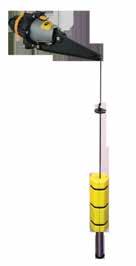
Seventy years ago, I cannot remember this worm being a problem in other months. However, about 50 years ago, it became an increasing problem over the whole year.
With our susceptible Down breeds, we drench the ewes prior to lambing and again at docking.
In spite of this, we have lost ewes six weeks after the second drench – in
late October. The worst affected ewes are those raising twins.
I believe that this worm has become more lethal in recent years, probably due to increasing survival of the larvae due to climate change with a more favourable environment.
As worm eggs hatch, they go through five stages of development before reaching adulthood. These are known as L1 to L5. The first three, L1 to L3, develop outside the host, enter
the host at L3 where they live off the animal and develop to maturity. Development from hatching to maturity normally takes about three weeks.
Unlike toxic FE spores, microscopic worm larvae move on grass and through soil particles; they need to remain moist to survive.
Australian scientists have found Haemonchus larvae 2m below the surface, descending to remain moist in years of drought. When rains come, they ascend

with the water levels to emerge on the newly sprouted grass in huge numbers. As I understand, this poses a far bigger threat than we see in New Zealand.
Scientists have estimated that larvae numbers in grass can exceed 10,000 in a kilo of grass. These larvae are mostly found 5cm above ground surface - about 80% - the rest either above that level or below ground level.
More than a decade ago, most of the North
Island had a severe drought that lasted for many months. Thousands of ewes were lost to the Barbers’ Pole worm. There were two contributing causes. First, their immune systems were weak because there was little nutrition in the stubble they were forced to eat. Secondly, they were ingesting high numbers of Haemonchus larvae at ground level. Sheep over the summer months can survive very well – so long as they
have water and parasites are kept at low levels.


The following point should be kept in mind and possibly considered in your management of the internal parasite problem.
Ensure that the animals’ immune system is in the best possible condition, with good nutrition to combat worm challenges.
If rotation grazing is not possible, frequent shifting to fresh paddocks will prevent stock grazing low where the majority
of worm larvae are present. This is particularly the case with lambs when their immune systems are still developing.
Saving areas of the farm for the lambs by grazing with only cattle over the previous 12-months will ensure that the worm larvae are at low levels which the developing immune system can mainly control, maybe with the help of an occasional drench.
Crops are always a good option, as worm larvae levels will be low, and the good nutrition will stoke the animals’ defence mechanisms in peak condition.
Low lying sheltered areas that remain moist are the best areas for worm larvae to survive. The same applies to fungi that produce toxic spores and cause the likes of FE, grass staggers etc.
Conversely, areas that are exposed and are dry will see fewer larvae survive.
Remember, drenching dose not only kills worms, it also gives the immune system ‘a breather’ and time to recover.
This is my take on minimising worm challenges by management, but there are still aspects that puzzle me that I do not know or understand.
• Gordon Levet is a longtime Northland sheep farmer and ram breeder
•
•
ALTHOUGH IRISH manufacturer McHale used the September 2022 Irish National Ploughing Championships to showcase the latest updates to its baler/ wrapper combination, it’s taken until recently for the first example to arrive in New Zealand.

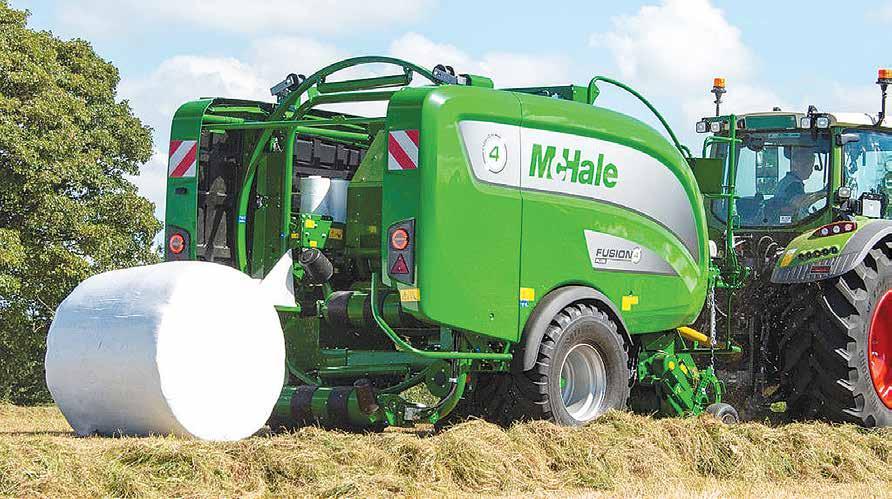
The New Fusion 4 combo is said to offer to greater comfort to the operator and improved efficiency in the field. This is largely thanks to an improved pick-up that promotes smoother flow into the baler’s intake channel.
The new range will include the base Fusion 4, the McHale Fusion 4 Pro and the McHale Fusion 4 Plus, equipped film binding technology. The latter with “film on film” will be the standard offering for NZ, although the other models are available under the indent programme.

All machines in the Fusion 4 range offer new features, while the higher specification Fusion 4 Pro and Fusion 4 Plus feature ISOBUS compatibility. This is said to offer higher levels of customisation that will lead to
increased performance.
A new 2.1 metre pickup, called the Profi-Flo, is designed to increase crop intake through more efficient crop flow. This, in turn, is said to increase throughput, bale density and wrapping speeds. Offered with a conventional 5-tine bar or camless, 6 bar format, the pick-ups feed a redesigned tapered feed chan-
nel that encourages the crop to flow from the pick-up to the rotor and onwards to the bale chamber.
The introduction of an Adaptive Intake, that automatically adjusts up and down to meet changes in crop flow, allows a more positive feed into the bale chamber. As well as gaining an extra tine, to reduce
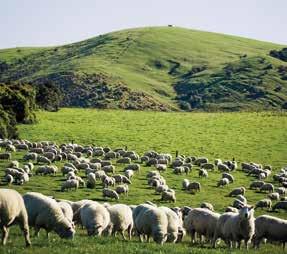
maintenance, the ProfiFlo pick-up is fitted with a heavier driveline which is intended to increase chain life.
All new balers are fitted with dual grease and oil pumps, connected to the movement of the bale tip, ensuring that grease and oil is applied evenly and continuously during operation.
Other detail changes
include a larger net/film brake, offering an extra 25% pre-stretch. This is said to be useful when operating in cold weather or when using film that needs a greater prestretch. For ease of use, a keypad is fitted to the rear of the two higher spec models, offering the operator the ability to control the wrapping unit and new work lights
fitted under the side panels. Modified cut and hols slider bushes help to avoid film tears in very dry or windy conditions. Meanwhile, an increase in the maximum bale density should lead to more tightly formed bales and better fermentation. A range of options includes a 1,000 rpm gearbox, providing better fuel economy and a 10%
increase in clutch capacity, achieved through reduced torque loading. Interestingly, the company suggests the optimal speed for fuel economy and output is around 890 rpm. However, depending on machine specification, there will also be options including selectable knives, a net loading device and side tipping of the wrapped bale.

IN A move that will make many other farm machinery companies sit back and scrutinise their marketing budgets, global giant John Deere has announced that it will withdraw from the November 2024 SIMA Event held in Paris.
This event is described as the international exhibition of technologies and solutions for efficient and sustainable agriculture.
JD says one of the main reasons for its decision not to attend is to allow a greater focus on country-specific dealer and customer events throughout the market-
ing year, rather than concentrating a large amount of its budget over just a few days.
“Covid-19 has changed the event landscape and the way customers want to interact with us is also evolving,” company sources have said.
The statement goes on to note that trade shows are a long-established way of engaging with farmers and contractors, but John Deere is exploring alternative communication channels that combine both digital and face-to-face activities. It also adds that the increasing emphasis on digital technology within farm mechanisation, the traditional way of interacting with custom-

ers may not be the most effective use of resources.
The move away from large international events could lead to a greater emphasis on supporting dealers at local shows and demonstrations. John Deere also makes a pointed reference to the conflict between SIMA and EIMA,
which stretched both the resources and patience of many exhibitors.
The company noted that in the future it would “welcome international trade fair organisations to review their current timetables to allow greater flexibility for other promotional activities”.
One wonders if this is a realignment of the way machinery companies will do business in the future.
This is at a time when large trade type shows have come under increasing pressure from exhibitors complaining about the increasing costs of attending such events, and from visitors who are
looking to see tractors and machinery in action.
Despite voicing these grumbles, the conservative nature of the industry continues to see many companies turn up at such events under the fear of missing out (FOMO), then postevent, wondering if it really was worth the time
and cost of attending.
In New Zealand, manufacturers are questioning the need to spend the whole month of March attending regional field days in Northland, the lower north Island and the South Island. Then, nine weeks later, attend the National Fieldays event in June.
Surely, it is time to look at re-evaluating the field days calendar to perhaps mimic the South Island landscape, when there are alternative events each year in Gore and Christchurch. Is there a likely need for the two North Island events to alternate and the national event to become biennial?
IN ALL areas of New Zealand’s agricultural or horticultural landscape, you would be hard pressed to find anyone who hadn’t been exposed to a Farmall tractor, whether it be a Model A, B, M –or one of the more recent models.

It’s not surprising then that global player Case IH is using 2023 to kick off global celebrations honouring the 100-year anniversary of the tractor.
The iconic Farmall model was initially introduced in 1923 as the all-purpose tractor designed to revolutionise the agriculture
industry. Initially, the tractor evolved from a 3-wheeled cultivator with an engine over the rear axle, that proved to be quite unstable.
Engineers moved to a chassis design and added a fourth wheel, pitching the new Farmall as a lightweight utility tractor against much heavier units such as the IH Titan and Mogul.

By 1931, the Farmall F was launched for farmers with more acreage, followed in 1939 by a second generation Farmall. In 1941, saw the arrival of the world’s first diesel-engine row crop tractor.

By 1947, the one millionth
machine rolled off the production line. This was followed by milestones over the next decades, including the first 2WD row crop tractor to exceed 100hp, sales in 125 countries and the 5 millionth Farmall built in 1974.
Having “disappeared” between 1974 and 2002, as company takeovers and acquisitions were the order of the day, the Farmall name was reintroduced in 2003 and saw Case IH continue to expand the line-up of products with up to 120 horsepower.
The Farmall legacy continues today with an offering of more than 30 models with ranges – such as the B, JX, C, U and JXM offer-
ing 30 to 140hp.
“In 1923, we set out to design a tractor that could replace horses, and today, our Farmall still serves as the workhorse on farms across the globe,” said Scott Harris Case IH global brand president.
“Generation after generation, Farmall has been a symbol of modern farming, and we’re excited to bring these stories to life over the course of 2023.”
The celebration will take place during a year-long, multi-faceted campaign, anchored in the concept of Farmall being “The One for All”, through social media, video stories and a dedicated microsite.
JOHN DEERE took the title of best-selling tractor brand in the UK in 2021, selling 3,558 units (25.3% of total UK tractor sales that year).
However, it fell to second place when the combined efforts of the CNH Industrial brands New Holland and Case IH amounted to 4,037 units (28.7%).
NH sold 2,682 and Case IH sold 1,355 units respectively, in a market of 14,071 new tractors registered.
As always, EU anti-competition legislation restrictions mean these figures are only published after 12 months have elapsed.
In third place, AGCO recorded 3,087 tractor registrations, for a 21.9% share of the total market, made up of 1,530 Massey Ferguson units (10.9%), followed by Fendt at 911 units (6.5%) and Valtra finishing on 646 tractors (4.6%).
Kubota was placed fourth on 947 units (6.7%), with rival Claas delivering 557 tractors and a 4.0% share of the market.
Elsewhere in the Tractor Top 10, JCB hit 261 or 1.85%, Same Deutz Fahr hit 257 (1.82%) and Italian manufacturer Agri Argo saw McCormick achieve 131 units (0.9%) and Landini 69 tractors (0.5%). Other brands made up 1,167 (8.3%) of the total.


CNH INDUSTRIAL, owner of the New Holland ad Case IH brands, has secured a minority stake in EarthOptics.

The US-based ag tech business was founded in 2018, to develop soil data measurement and mapping technology.
CNH Industrial is not alone in the latest US$27.6m round of funding with Bayer, Syngenta and Elanco also partners in the start-up as are several venture capital businesses looking to enter the field of soil data measurement and mapping technology.
Combining data from ground-based sensors, satellites, soil samples and machine learning models, the company delivers a wide range of data to help boost yields and reduce fertiliser application, alongside soil mapping platforms and a system that precisely identifies the areas and depths where fields are compacted.
A pilot testing phase of the soil sensing technology will be conducted by Case IH this year, with the goal of accelerating levels of tillage automation to provide greater agronomic insights for customers.
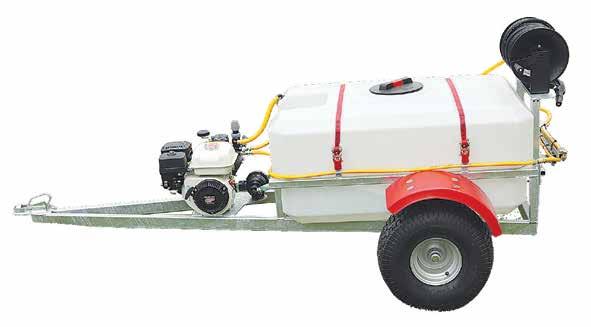



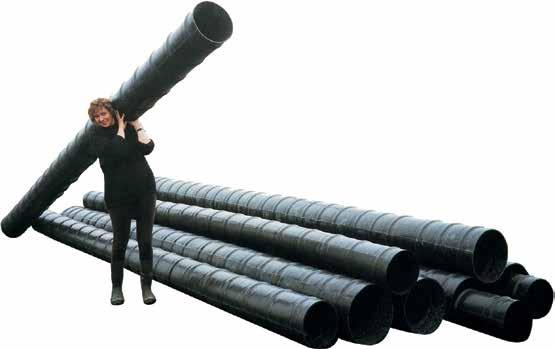





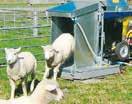



















“WE ARE confident of putting on a good event.” That’s the word from Jonathan Paul who’s the event organiser of the Central District Field Days, which runs from March 16 to 18 at the Manfield raceway in Feilding.


Last year the event had to be cancelled because of Covid. However, Paul says they have been running the event for almost 30 years and they are well practiced at changing plans and building the event back up.
“It’s businesses as usual and it’s been positive to see business engaging and their keenness and willingness to get back in front of an audience and the community,” he told Rural News “We have been really pleased with the inquiries coming through from exhibitors and hearing how excited they are to get to Feilding and meet customers.”
CD Field Days attracts close to 30,000 people over the three days and is a much anticipated event and a highlight of the year for the rural sector. Feilding, the town where the event is based, is one of the significant agricultural hubs in NZ – where companies ranging from the machinery, finance, agricultural consultancy, the livestock sector and a raft of other ag organisations are based. The local saleyards service the whole of the lower North Island.
The 33 hectare Manfeild site is normally a motor racing track, but for three days it is transformed into a significant and well laid out field day.
Paul says the event acts as a connector for communities in the cen-

tral region and is designed to cater for all interests and tastes. A feature this year will be the RNZAF flying in one of their helicopters from the nearby Ohakea airbase and this will be a popular static display.
“The event showcases cuttingedge machinery and equipment, the latest developments in rural innova-
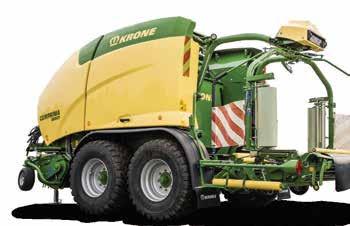
tion, thrilling FMX shows, lifestyle trends, top-notch regional food and local brews,” he adds. “You can score yourself a heap of exclusive event deals and have the chance to yarn with sellers and exhibitors. It’s a great time to stock up, plus there’s fun and freebies for the whole family.”
As well as catering for farmers and
townies alike, a special aspect to the CD Field Days is the attention paid to young people to get them interested and inspired to potentially take up a career in the primary sector.
“We offer free tickets for students, and we know that a lot of schools take advantage of that and come along on the Friday especially to get around the
exhibitors,” Paul says. “The civil contractors will have a special marquee there to highlight the career opportunities in that sector as well.”
Paul says the great thing about the event is that it brings everyone together in one place and allows people to connect, gain knowledge and experience the NZ primary industries.
Preapproval is now a lot easier with online tools that can give a definitive answer within a few minutes. Preapproval can also be granted by answering a few simple questions over the phone, which makes the process simple and straightforward.


DEVELOPED BY Roger Dalrymple, the Flexifeeder and Flexifeeder skid troughs are designed to reduce feed wastage.


The troughs are easily configured to suit different mobs and offer substantial savings for a relatively small investment.
The Flexifeeder is sold in 20 metre kitsets, complemented by highquality, stainless steel componentry. There are units for single or double-sided feeding, with the option of a high side on the single units to stop feed being “nudged” out by animals.
The heavy-duty version incorporates a 6mm cable to support the liner, with the addition of a 4mm integral cable for addi-
tional strength. Steel posts supplied with the heavy-duty option are covered with polyethylene to protect them from corrosion resulting from the silage. The inherent flexibility of the design


ensures any animals that get pushed or bumped are not injured and any machinery coming into contact is not damaged.


A choice of models sees the single-sided at 900mm wide by 450mm

high, the double-sided at 1,100mm wide by 450mm high, all sold in 20 metre lengths, or single and double “high-sided” units sold by the metre lengths.
Flexifeeder Sled troughs are easily moved onto
‘clean’ ground by a UTV, ute or tractor and offer the ability to accommodate up to 40 large beasts or dairy cows. Available in Drive Over, MiniSkid, Medium, Large and Jumbo Skid options the range can be delivered in 4, 6 or 10 metre lengths.

Drive Over units measure 280mm wide x 220mm high, Mini Skid, 280mm wide x 280mm high, Medium Skid, 750mm wide x 500mm high, Large Skid, 1000mm wide x 500mm high (water proof option available) and Jumbo Skid, 1100mm wide x 550 high. www.agbits.co.nz


AS PART of their induction, Alliance Group’s four 2023 graduates partnered with an award-winning chef to cook a special evening meal for families staying at Christchurch’s Ronald McDonald House on Tuesday 31 January.
The independent charitable trust provides free accommodation and support to families who need to travel away from home for their child’s medical treatment.
Abigail Stewart, one of the four Alliance graduates preparing the meal, said that along with the privilege of cooking alongside acclaimed chef Darren Wright, who works in Alliance’s food service team, the evening was a great way to bring a smile to the faces of families staying at Ronald McDonald House.
“Our hope was the meal would
give families a chance to take their minds off the difficult times they are facing.
When they took a bite of the slow-cooked Silere lamb oyster shoulder and we saw joy on their faces, it reinforced the importance of small acts of kindness and how these small gestures make a real difference to families experiencing tough times.”
Alliance developed its partnership with Ronald McDonald House in 2021.
The co-operative provides meat to and supports a number of fundraising events including Supper Clubs in Christchurch, Queenstown and Invercargill, corporate gifts at Christmas and participates in the Family Dinner Programme. Alliance Group interim chief

executive Willie Wiese says Ronald McDonald House holds a special place in the hearts of Alliance’s people and the broader community
“A number of our employees and shareholder-farmers have either used the services Ronald McDonald House provides, or know families who have.
We recognise the important role it plays, particularly for people in New Zealand’s more remote communities.
The trust’s amazing work also aligns with our values of care, compassion and commitment.”
Ronald McDonald House National Corporate Partnerships Manager Nadine Cooper said that it was wonderful having the Alliance graduates and Darren Wright to cook for the families.
A STRONG supporter of CD Field Days is Federated Farmers Manawatu/ Rangitikei provincial president, Murray Holdaway.
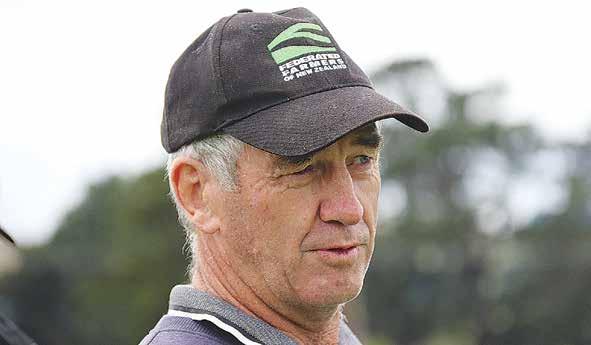
He says one of the big things that came to light during the Covid crisis was the networking opportunities that are available to farmers. He says these are critical in the growth and development of the agriculture sector.
“The CD field days is a prime example of a networking opportunity. It’s not just about talking to farmers, but it’s about seeing some of the new products, research and technology that’s available,” he told Rural News
He has been a regular at the CD Field Days and will be there in March on the lookout for new ideas, innovation and to meet people.
Holdaway is a true farming leader and is the fifth generation of his family to run the property. Since he took it over in 1979, he’s bought up other adjacent farms and expanded it from the original 80 hectare farm to the present 150 effective hectares, running 445 cows. He’s been heavily involved in environmental issues and in particular he’s been a strong supporter of the use of plantain as a tool to
“We have done all sorts of things such as establishing our eco
reduce N levels in pastures.
Holdaway’s been part of that small group of farmers in the Tararua District selected to participate in the plantain trial. His property has become one of the monitor farms were trials have been undertaken and some of the scientific data gathered. It is also where field days for farmers have been held to show the benefits of this forage. As a result of becoming involved in environmental issues, he says he has made many changes to his own farm.
“Since then, every decisions we have made on the farm has got an environmental component to it,” Holdaway explains.
“We have done all sorts of things such as establishing our eco irrigation system. We have closed down one creek crossing and bridged another and fenced all our waterways and with
the new shed we reticulate some of the water. There are so many little things we do just on daily basis and it’s now part of our thinking.”
Holdaway says he’s a proud dairy farmer and has no hesitation when he goes into town to tell people what he does.
He says one of the things that really has lifted his spirits in the last eight months is that more of the population are beginning to understand the value of agriculture.
“That is something we have always had in the greater Manawatu but not necessarily around the rest of the country,” he adds.
“People are starting to recognise that upper Rangitikei and the Manawatu is the most intensive lamb finishing province in NZ and that’s huge. We have got an extremely diverse ag sector in the region and its economic value is huge.”
Murray Holdaway is a strong supporter of the CD field days.
■ Ideal for shearing sheep, alpacas, goats and cow tails.


■ Variable speed from 2600-3500 rpm.
■ Latest brushless motor technology means minimal heat build up
■ 1400gms means 100-200gms lighter than standard handpiece.
■ At 2800 rpm the 12-volt lithium battery will crutch 300-400 sheep or trim 400-500 cow tails.
■ Tough alloy switch box with auto rest fuse for overload or lockup –clips to belt.

irrigation system. We have closed down one creek crossing and bridged another and fenced all our waterways and with the new shed we reticulate some of the water.”

particularly when operating in wet conditions.
MCINTOSH OF Palmerston North has a reputation for building feed equipment with a robust construction, clever engineering and a long working life.
The company’s Double Bale Feeder builds on this reputation and offers the ability to deal with round or square bales.
From a practical point of view, one of the worst traits of a “normal” bale feeder is the tendency to run over the feed it has just delivered. In the case of the McIntosh Double Bale feeder, a 315mm overhang from the tyre edge to the outside of the bale feeder frame means that delivered feed is never “run over” and pushed into the ground and wasted. This represents a huge cost saving,
The construction layout sees two box sections running through the bale cradle to increase overall strength, while also lowering the overall loading height and centre of gravity, promoting stability and safe use on hillsides or sloping ground. A choice of wheel settings enhances safe operation on difficult terrain, and buyers have the option of fitting larger tyres.
Standard equipment features 11.5 x 15.3 tyres, a detail that helps to reduce rolling resistance, making towing easier in poor conditions, with the option of increasing the footprint by fitting 400/60x15.5 tyres for poor conditions.
At the rear, an overdimensioned lifting arm can deal with the heaviest bales, while also offer-

ing the ability to carry a second bale to the feeding area. The design features twin lift rams which gently lower the bale onto the unrolling cradle and help prevent damage to the feeder bars.

The unrolling cradle uses a zinc-plated, 12,000lb-rated chain, with slow running shafts utilising bronze bushes for resistance to silage juice and a greater service life. Unloading slats are manufactured from 8mm steel with integral teeth to promote bale rotation by increasing the contact area, while in the cradle, aggression pins restrict bale movement to encourage the teeth to pull the bale apart. The large hydraulic motor comes with a 1 ¼ shaft
and heavy-duty key. From a practical point of view the machine includes a rubbish bin, and a chequer-plated platform on the drawbar a-frame to allow the user to safely remove the film and net wrap.
Practical options include a third central tine for the rear lifting forks, said to be useful for dealing with soft or mis-shaped bales, while for those handling square bales, lateral extensions, each carrying an extra tine, ensure positive lifting onto the cradle. If handling chopped bales, users can specify front and rear infill panels to stop material being lost before it heads up the discharge conveyor. In addition to the lateral extensions, those feeding squares might also option the machine with siderails for the bale cradle.

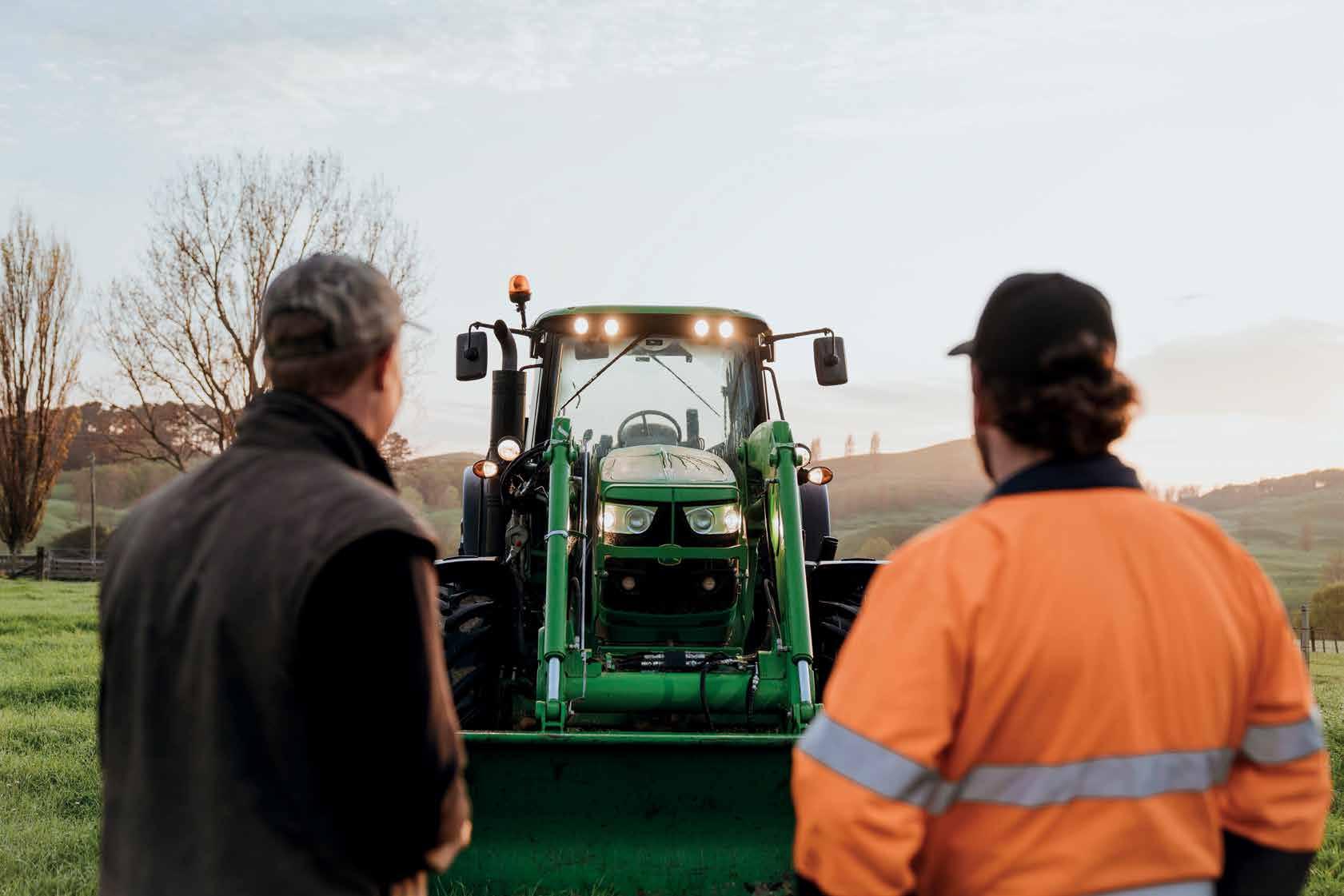

HANSEN PRODUCTS’ Easy Fit ID range of compression fittings are designed to fit LDPE and HDPE poly water pipe from 15 to 40mm diameter and 15 to 50mm sizes respectively.
The fittings can also be used for MDPE in sections from 15 to 110mm, using a conversion kit.

High pressure rated to 16 bar /235psi for the 15 to 50mm sizes, the fittings are manufactured in New Zealand using high-quality, “virgin” polypropylene, that is said to offer exceptional resistance to weather, termite, fungi and bacteria.
The construction of the fittings sees high-quality threads for dependable high-pressure connections, a pre-lubricated seal assembly that aids insertion and prevents leaks and easy-grip, locking nuts to establish a secure connection.
Fully compatible with the wider range of Hansen products, the fittings are approved by the Water Research Council for use with potable (drinking) water.


www.hansenproducts.com
 MARK DANIEL markd@ruralnews.co.nz
MARK DANIEL markd@ruralnews.co.nz
THE BRANDT Group of Companies recently acquired the assets of AGrowQuip NZ Ltd.


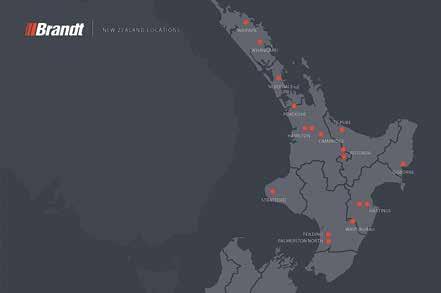
This transaction came into effect on 30 January 2023. Brandt Group says it will ensure access to the industry’s broadest support infrastructure for customers throughout the North Island – delivering the products, parts and service they need, wherever they are operating.
“Our customers can look forward to service enhancements via investment in a best-in-class field service truck fleet and upgrades to existing facilities,” says Brandt chief executive, Shaun Semple.
“Brandt is fully committed to building a comprehensive dealer infrastructure that delivers unmatched support for New Zealand construction, forestry and agricultural businesses, every single day.”
With this acquisition, Brandt now owns and operates 138 dealerships across New Zealand, Australia and Canada. The company’s extensive experience in the agriculture, construction, and forestry sectors enables them to deliver the quality products and industry-best support services that New Zealand equipment owners need to help them grow their businesses.

“As a family-owned business for over 90 years, Brandt’s number one focus is always on the people and our customers,” Semple adds.
“Whether it’s getting to know our new team, helping our customers succeed or supporting the communities in which they live, we look forward to deepening our roots on the North Island.”
be done in two hours we don’t do it.”
IN THE build-up to the CD Field Days, another popular event is taking place in Palmerston North the week before – the Ford Ranger Rural Games.

These are being held from March 10 to 12.
About 50,000 people are expected to attend the games, which are held in the city’s spacious square and admission is free. A feature of the three days is NZ Rural Sports Awards, which will be held on the Friday evening and already the dinner is a sell-out with 400 people booked to attend. Awards are meted out for excellence in a range of sporting categories.
The games started back in 2011 – the year
the rugby world cup was played in NZ. They were initially held in Queenstown, but after two years was relocated to Palmerston North where it’s been held ever since.
Founder of the Rural Games Steve Hollander says the idea came out of the view that generally rural sports, which are
part of NZ’s history and heritage, were not getting the profile they deserved. While sheep dog trials and sheep shearing competitions did appear sometimes on television these were not easily accessed by the general public.
Hollander says the idea was to ensure that
the existing competitions such as fencings silver pliers, the Golden Shears and the dog trials were retained, but that a new format was created to make these activities more appealing. He says it was a case of getting these sports on board and them feeling comfortable with the change.
“So, we tried to model it along the lines of T 20 cricket,” Hollander told Rural News. “For example, we called wood chopping timber sports and that means we can get the whole competition over in 2 ½ hours. The same with sheep dog trialling and tree climbing. Essentially if it can’t
Hollander says another example is speed shearing, which used to happen in rural pubs for many years. He says they now have the speed shearing championships where the top ten speed shearers compete.
This year will see the inaugural Golden Loader Forestry Championship included in the programme. This will see two competitors racing against each other and the clock to load and unload a truck and trailer unit. Entries are limited to 24 and only those who currently work in the sector and have their loader ticket can participate.


Hollander says it has been a long-term ambition of the Rural Games to host a forestry
championship, alongside traditional sports that helped to build our nation.
“Forestry is a huge part of rural New Zealand and it’s only fitting that we celebrate its role by creating a championship highlighting the skills required to drive forestry machinery,” he says.
Another crowd pleaser is ‘clash of the colleges’ where pupils from secondary schools in the lower North Island who dabble in agriculture, compete in a variety of events. There is also a careers hub at the Rural Games aimed at attracting young people to make their future in the agri sector.
Hollander says it will be great to be staging the games again after they were cancelled last year because of Covid.

ROTORUA BUSINESS
Unearth Ag has been recognised as one of Australasia’s leading independent precision agriculture technology providers.

Director Matthew Gray was recently named the Ag Leader ANZ Dealer of the Year, ahead of 60 other dealers across ANZ. Gray has more than 20 years’ experience in intensive farming, farm machinery and precision agriculture technology.
Raised on a mixed cropping and livestock farm near Gisborne, he completed a Bachelor of Commerce at Lincoln
University, followed by a graduate exchange program with Ohio State University.
Working at a large agribusiness with interests in farm supplies, crop protection, farm machinery, agronomic services, finance, insurance and farming in Kentucky, Gray was mentored by well-known UK agronomist Phil Needham, who encouraged US farmers to adopt intensive European cropping systems that ultimately helped double Kentucky’s average wheat yield in 20 years.
He returned to New Zealand and worked as a farm machinery operator, service technician,
precision ag product specialist and precision ag business manager before establishing Unearth Ag in 2016.
“Our goal is to help
farmers and contractors to gain a true view of the performance of their cropping operations, thereby helping to improve their pro-
ductivity and profitability,” Gray says. “This can be anything from simple guidance systems, through to fully automated maize planters,

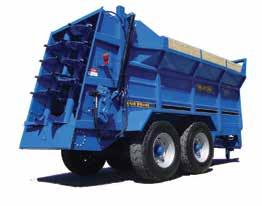

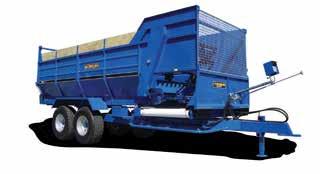
precision control systems for sprayers and spreaders and yield monitoring.”
Unearth Ag works closely with maize growers throughout the upper North Island.
“As a precision ag specialist, I help fill the gaps between what comes with machinery and what you can do with aftermarket options. Typically, our customers start with auto-steering before they realise the potential of this technology.”
Gray suggests that beyond auto-steering, there is only a small step to being able to precisely apply inputs based on known yield data. He also believes that the
incorporation of ISOBUS technology in modern machinery is a gamechanger, giving farmers modularity in hardware, allowing different brand GPS displays talk to rate controllers.

His focus on the Ag Leader range allows entry-level steering systems right through to precision application, yield monitoring and data management, using proven, easy to use, and durable technology made in North America.
“It’s a good product that is backed by people who know what they are doing and is backed with ongoing technical support,” Gray says. www.unearthag.com
ROTORUA’S BRUCE
Calkin had been feeling optimistic.
He had just finished seven rounds of chemotherapy for throat cancer and was awaiting the news of his results.
However, he never dreamed he would also receive the news from New Zealand National Fieldays Society chief executive Peter Nation that he was the winner of a brand-new Isuzu D-Max.

“You’re bloody kidding me… I can’t believe it,” he said on the phone after realising he wasn’t being scammed.
The prize, a white Isuzu D-Max LX Double Cab Auto 4WD, is valued at $61,990 and includes all on-road costs.
“I thought he was having me on,” Calkin says. “It started to sink in when he said that I’d attended Fieldays and scanned my Smart Band to enter the draw to win a ute and that I had won it”.


“It couldn’t have gone to a more deserving winner,” Nation says.
Calkin, who works for electricity and fibre solutions company Unison based in Rotorua, attended Fieldays with wife Julie on Saturday 3rd December.
Last year, the fourday event moved to the summer dates to play catch-up after Covid.

“We usually attend Fieldays every year, but Covid put a stop to that for a bit. It’s been a pain in my backside really”,
Calkin says. “When I was diagnosed with cancer, I had to undergo a pretreatment and have a tonsillectomy, then Julie got Covid, then I got Covid. So, it all got delayed. I didn’t end up starting treatment until September”.
When they heard Fieldays had moved to the summer dates, the Calkin’s thought it would be a good opportunity to attend again and have a day out.
“We brought a truckload of beef jerky, some wine and spent time looking at the range of outdoor fires,” he says. “It was good to be back, it’s always such a great event”.
Collecting a Fieldays Smart Band at the gate, he registered his details and scanned it on the Isuzu site and dropped it into the back of the ute at the end of the day.
“Never in a million years did I think I would win it. I have only ever won $100 at Lotto; seems my luck might be changing.”
Handing over the keys to the Ute was Isuzu Utes New Zealand General Manager Scott Kelsey.
“The first place I’ll be driving it is around town for everyone to see, stopping in to show it off to family and friends”, Calkin says. “Then we will head to the Redwoods with the bikes on the back. The last year has been pretty brutal, but you know it could be worse and at least I can still get out on the trails”.
THE MANAWATŪ District has a large and diverse agricultural sector producing high quality

dairy, red meat and forestry products to the world.

The agri-food sector, which includes primary production, agricultural

support services and all secondary food and agricultural manufacturing, is our largest sector – contributing $340.2m in GDP to the local economy over
the year to December 2022 and employing 3,201 people. This is 22.6% of total local GDP and 24.2% of total employment.
Of total agri-food sector activity, primary production makes up $215.6m of agri-food sector GDP, primary industry support services contribute an additional $33.3m to the local economy while value-added agri-food manufacturing generates a further $91.3m to local economic activity.
Primary industry employment is the largest contributor to the local economy creating 1,696 jobs. Primary production support services contribute a further 390 local jobs while value-added manufacturing employs a further 1,115 people.
Of all agricultural activities in the district, dairy production is the largest primary sector earner contributing $109.5m in GDP and 714 jobs to our local economy. The contribution of the dairy sector to economic activity in the district is substantially larger than for the New Zealand economy as a whole.
To demonstrate the scale of the local industry relative to New Zealand, local dairy production contributed 7.3% of total GDP ($109.5m) and 5.5% of local jobs (714 jobs) to the district economy over the year to December 2022 compared with 1.9% of total national GDP and 1.1% of total jobs. Dairy production has been a
stalwart in the economic performance of the district over a period of substantial disruption and is expected to continue to substantially bolster local economic activity over 2022.

Manawatū District has had substantial professional, scientific and technical services industry grow around our dominant food producing industries over the last 20-years.
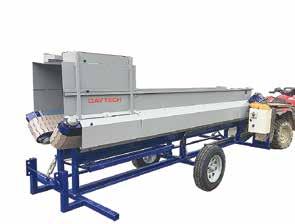

Feilding boosts the largest stock saleyards in the Southern Hemi-


sphere, situated in our town centre. These saleyards attract buyers and sellers from around NZ on a biweekly basis and are a key contributor to our local retail, hospitality and professional business community.
Feilding is also the home to Manfeild Park, with the agri event stadium which hosts many diverse agricultural and equestrian events such as the Central District Field days, NZ Dairy Event, A&P Shows etc.
The Manawatū Dis-

trict Council has proudly supported the rural community through good and hard times – including Covid and the adverse events which continue to challenge us.


It is great to have an event such as CD Field Days taking place this year as it will no doubt lift the spirits of the people of this district and the wider lower North Island. I commend the organisers for staging this brilliant event.
• Helen Worboys is mayor of the Manawatu District.


Palmerston
MAKE NO mistake, Manawatū’s primary sector is vital – not just for the prosperity of the region and the city of Palmerston North, but also for the whole country.
Responsible for almost 50% of the wider region’s GDP, Manawatū’s primary industries provide the foundation for almost everything else.
And we are arguably the country’s most diverse agricultural region.
From venison farming in the north, to pork, poultry and vegetable produce in the south, Manawatū with Palmerston North at its centre, is New Zealand’s ‘Food and Fibre’ capital.
For instance, dairy product manufacturing was our largest export in 2022 contributing $439.4m in revenue for the city’s economy. Over the past 150 years, these strong agricultural underpinnings have allowed Palmerston North to develop its own diverse, multi-stranded and resilient economy.
It’s an economy that is performing well despite Covid, inflationary pressures, and recent weather-related events.
However, during the district’s early pioneering days, it was never
certain that the small swampy settlement in the Papaiōea clearing would one day become Manawatū’s principal town.
Foxton was the established river port connected to Palmerston North by a tramway, while Feilding was also growing at a comparable rate.
However, with the railhead for the privately owned Wellington & Manawatū Railway Company established at Longburn in 1886, and completion of the linking Hawke’s Bay line five years later, Palmerston North gained the edge.
1886 was also the year that the Manawatū and West Coast Agricultural and Pastoral Association established the Palmerston North Showgrounds.
So, in a mere 30 years from its founding, the young town had become a recognised centre for
North mayor
farming and the major shipping point for the region’s stock and produce to the seaports at Wellington and Napier.
As a writer in the Wanganui Herald observed at the time:
“From its central position and the command it has of the railway routes, Palmerston North seems destined to become in the interior what Wellington is on the seaboard – ‘the great inland distributing port’.”
Even truer now than it was then, this feature was immediately attractive, and not only to the farming community, but also to enterprising business owners who could see potential in the cleared and fertile Manawatū plains and the town that serviced them.
Among those early agri-centred initiatives was Glaxo milk powder, New Zealand’s first designated Royal Show, the
Eclipse Wire Company, Farmers Mutual (FMG), Massey Agricultural College – now Massey University, and the NZ Dairy Research Institute –now the Fonterra Global Research & Development Centre.
and agrifood companies, research institutes, entrepreneurs and investors; as well as established and developing intermodal distribution networks.
Later came Norwood Farm Machinery, Allflex International, NZ’s first International Agricultural Aviation Show, NZ Pharmaceuticals, and then in 1993, the Central Districts Field Days.
This heritage spirit of agri-sector and agribusiness innovation and progress is very much alive and well today.
In 2013, FoodHQ - a collaboration involving NZ’s leading food science and research institutes - was established to add value to NZ’s primary produce and food chain, moving into Te Ohu Rangihau Kai – the National Food Science Building at Massey University - in 2021.
Manawatū became the first region in New Zealand to develop an agritech strategy with the ambitious goal of becoming one of the top three global agrihubs in the world.
Within our concentrated and central geographic footprint are all the elements necessary for its realisation.
They include an influential cluster of agritech
The number of people working in this valueadded sector is also way higher than the national
average. The combined returns from agri-food manufacturing; professional, technical, research and scientific services; logistics and distribution are circulated several times through the local economy.
trict Field Days is a celebration of our agricultural heritage, present agribusiness profile, and future agritech potential, and we welcome its 2023 return to Manfeild with open arms.
Rightfully, Central Dis-
• Grant Smith is the Mayor of Palmerston North

Also
• Grow vegetables all year round and extend your growing season.

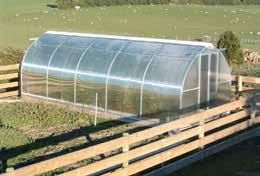

• Very affordable and easy to install.

• Strong construction that resists all weather conditions.
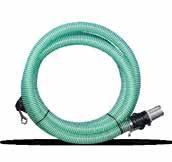
• Over 10,00 happy customers
• 100% New Zealand made.
• Range of models 2m to 10m long.


• Nationwide delivery available.
Grant Smith says Manawatū’s primary industries is responsible for almost 50% of the region’s GDP. www.morrifield.com
OVER THE years, Ashburton-based Rotowiper has followed one main objective: to design and manufacture an effective, cost-efficient method of controlling/eradicating weed infestation in pasture and crops.


Receiving positive feedback from farmers and growers around the world, the company has achieved its main objective. However, recently it has been developing new formats to meet individual conditions in different markets around the globe.

The new Rotow-
iper TR series is a case in point. It is proving to be very successful, featuring ease of operation with simple height adjustment, delivered by a new single heavy-duty ratchet assembly. Likewise, the roller drive engagement
is actioned with a simple spring-loaded pin, meaning the machine can be quickly disengaged for transport or re-engaged once back in the paddock.
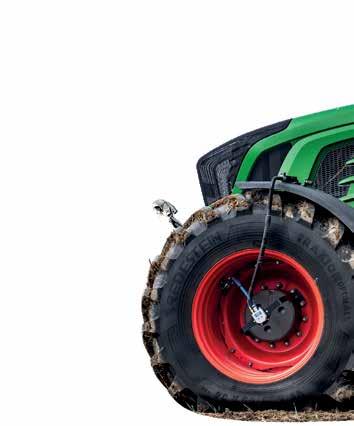

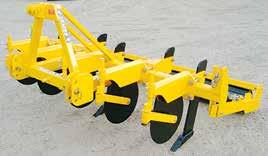


Other features include a drawbar that can be raised vertically for trans-


porting or storage, without tools, and stainless steel covers throughout to give the machine a quality appearance. However, more importantly, this also delivers durability and improves the machine’s longevity.
A redesign of the frame features larger box section steel, and a “box” style frame layout, both resulting in superior strength and durability. Heavy-duty stub axles are equipped with high-speed bearings to
help endure the rigours of high-speed road travel road travel alongside the punishment delivered on unmade farm tracks and large acreages.
For those using ATV or UTV style towing vehicles, the chemical tank has now been repositioned from the drawbar to above the application roller. This has removed weight transfer from the rear of the vehicles, while also allowing a levelling device to be fitted – if required.

Rotowiper is able to offer a bespoke production and configuration service. The company recently completed its largest machine to date,
offering a 24-metre working width and one metre clearance under the application roller. Comprising seven individual roller sections, the machine was developed for a Canterbury contractor who was dealing with bolters in the increasingly popular fodder beet crops being grown.
The machine’s layout allows excellent ground contouring over the full working width. By using a combination of hydraulic and electronic control, it quickly moves on from its original intended use by also dealing with other weeds such as Californian thistles.
www.rotowiper.com



using a simple singlelever operation.




KUBOTA NEW Zealand has recently added to its product line the new U10-5 excavator that will replace the existing K008-3.
The new machine has been updated with a range of new features, particularly on the operator platform. A zero-tail swing machine designed to operate safely in the tightest of spaces, complemented by hydraulic controls and variable track width, means there’s not many jobs the U10-5 can’t get to.
The U10-5 features hydraulic control levers, positioned to the sides of the seat for a better, more relaxed operator working experience. This ensures operator comfort and reduced operator fatigue.

With a focus on safety, it has an engine safety start system that prevents starting when the levers are lowered. This means there is no unexpected excavator or attachment movement at start-up.

Hydraulically adjustable track width from 750mm to 990mm allows navigation in tight spaces,

For operating in areas with restricted height, a newly designed front foldable Roll-Over-Protection-System (ROPS) allows the U10-5 to fit under doorways or low-hanging branches.
Returning the ROPS back to the working position is simple and provides protection for the operator.
Weighing in at 1.2 tonnes, the machine has 10.3hp maximum output, a bucket breakout force of 1,060kg and is easy to tow behind suitable vehicles

Carrying over features from the K008-3, the U10-5 still includes the TPSS Track Pattern Selection System and twospeed travel pedal. This allows users to switch between high and low speeds.
Servicing is achieved via a fully opening engine cover, while the hydraulic service port pipes are conveniently located for easy maintenance.
The new ultra-compact excavator features a modern exterior design as in the current range as well as a new LED boom work light to extend the working day.
increasing production in grassland and arable operations.



REDUCING SOIL compaction has been recognised for many years as an efficient method of


While there are many products in the marketplace, key design features can have a major effect
on efficiency, horsepower requirements, output and ultimately, the final surface finish.
The James Soil Aerator was designed and built to overcome compac-

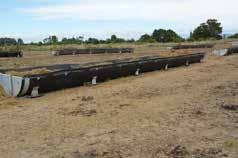


tion in heavy soils. This is evidenced by surface ponding after rainfall, shallow root systems and restricted plant growth or output.

The five-leg aerator is
a linkage-mounted design. It is centred around a heavy-duty frame for durability with inherent weight to aid penetration in difficult conditions. Operating to a working depth of 23cm. The initial lifting and subsequent “wave” effect creates a vertical slot and horizontal fissures, creating drainage, oxygenation and deeper root systems.
The process also promotes the release of “locked” minerals that are typically unavailable because of a lack of oxygen. MAF trials in Southland showed that “aerated” paddocks on average produced 21.7% more dry matter over a 15-month period.
Up front, individual disc assemblies’ slice through the surface and shallow root systems to allow easy entry for the aerator leg. This also reduces surface damage to the sward.
Each of the five legs, manufactured from highgrade carbon steels, are inclined slightly forwards
The process also promotes the release of “locked” minerals that are typically unavailable because of a lack of oxygen. MAF trials in Southland showed that “aerated” paddocks on average produced 21.7% more dry matter over a 15-month period.
to aid penetration and “pull” the machine into the ground. Each leg is also fitted with an adjustable and replaceable shin to prevent excessive wear to the main part of the leg.
At the base of the leg, a heavy-duty “frog” assembly carries a replaceable point that creates the initial “lift” and initiates the “wave effect”. This creates ground shatter and allows working depths of up to 25cm.
Integral to the machine is a hydraulic auto-reset system that removes the problem of overload and the
frustratingly time-consuming issue of broken shear bolts. Importantly, the system can be easily adjusted to suit prevailing conditions— such as rock burdens or sub-surface timber. At the same time, it also acts as a shock absorber system for the aerator and the tractor rear linkage.
At the rear of the machine, a full width smooth roller and scraper assembly serves to level any surface imperfections. This ensures that pastures or paddocks can be returned as quickly to onward production. www.james-engineeering. co.nz
ods of managing slash and debris on their sites.
WITH THE current issues of forestry ‘slash’ continuing to be a major problem in high rainfall events, a new take on an old method to deal with the forestry waste is set to help Kiwi logging crews better manage skid sites and landings, which could in turn increase productivity.
The locally developed Falcon Slash Grapple Rake fits around two of the most common sizes of Ensign grapple. An independent study shows it can reduce the laborious task by as much as one hour a day, while improving safety and environmental outcomes.

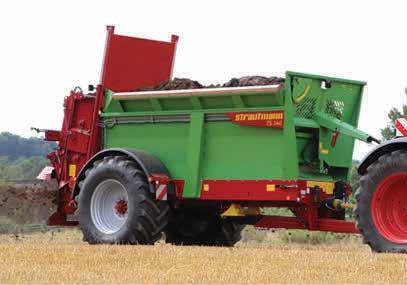
The idea for the new attachment came from Moutere Logging M3 Crew manager Steve Johnson, who was frustrated with existing meth-
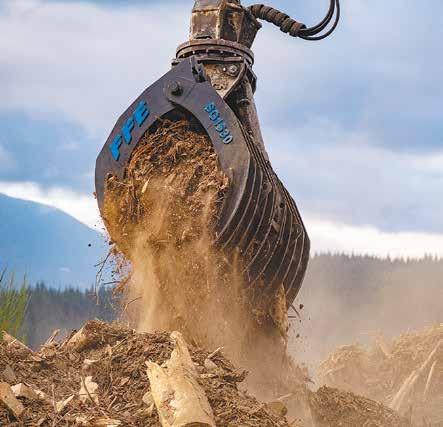
“I was up on the skid for three hours one evening moving slash for management purposes and thought ‘there’s got to be a better way’ as I continued to pick up small loads,” he explains.
The Grapple Rake consists of a one-piece spring lock system to attach to either side of a standard Ensign grapple, commonly used for loading. It can grab huge amounts of slash in one go, which can then be precisely placed in a designated area.


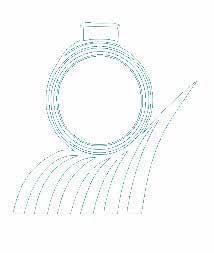
During the design phase, three key points were considered. Firstly, it needed to be quick to attach and remove. Secondly, it needed to have minimal maintenance and accessories, with no additional plumbing.
Third and finally, it needed to be able to still
be used for logs – jobs such as loading or sorting – if needed.


“Clearing slash from skids and landings can
be a real headache,” says Darrin Barr of DC Equipment, the company behind Falcon Forestry Equipment products.
“It can slow down operations and make them unsafe if you don’t keep on top of it. More importantly, it needs

dealing with in an environmentally responsible manner, ensuring it doesn’t end up in waterways or impede access. Simply pushing it over the edge of a slope might not be the best way to deal with it.”
DC Equipment has designed two versions, working in conjunction with a local engineering company; one to fit the Ensign 1530 and a larger model to fit the Ensign 1730 – weighing 1,100kg and 1,200kg respectively, in addition to the weight of the grapple.
Fitting or removing
from the host grapple takes around three minutes.
The versatility of the Falcon Slash Grapple Rake has been highlighted due to its ability to augment an existing Ensign Rotating Grapple. Along with its ease of use, both aspects grabbed a lot of attention at the recent Rotorua Forestry Show.
The company notes that operators of other grapple brands should get in touch, with a view to including ongoing development to fit these units.

www.falconforestryequipment.com

“I was up on the skid for three hours one evening moving slash for management purposes and thought ‘there’s got to be a better way’ as I continued to pick up small loads.”
WELL KNOWN motor industry face Tom Ruddenklau has been appointed as chief of the Morrinsville-headquartered, Power Farming Group.

Brought up on a beef and sheep farm at Dipton in Southland – famous for also being the home of former Prime Minister Bill English – Ruddenklau’s interest in things mechanical started when he helped in his father’s secondary contracting business.

After university, a young Ruddenklau took up positions in the motor industry in the UK, before returning to New Zealand to lead brands such as Hyundai and Volkswagen. During that time, he was instrumental
in establishing the sponsorship package with the iconic Country Calendar programme that endures to this day.



“Joining the Power Farming Group has fulfilled an underlying desire to get back to my rural roots and the engine room of the nation,” he says. “What could be a better job than leading the largest privately-owned importer, distributor and retailer in the Southern Hemisphere and be there to see that business develop in a time of complex regulatory changes?”
Initially, Ruddenklau will take the time to understand a business that is obviously in good health, with operations in New Zealand, Australia and the US. He notes that PFG is very focused on its people, typified by its

joint venture retail operations throughout NZ.



“Our JV’s are built around committed individuals who have some skin in the game,” he adds. “Rural business is undoubtedly built around people, complemented by great products and supported by 5-star back up when the do-do hits the fan.”
Ruddenklau told Rural News that the PFG stable houses some great brands sourced from around the world, including UK brand JCB. He says these will support its latest venture, Power Farming Construction, which will give the company the ability to fill the farm shed even more.